Trip report - Teslin and Yukon Rivers, June 2016
Earlier this year I took up the generous offer from Fabian of Bushcraft Yukon to embark on a ten-day, 400km trip down the Teslin and Yukon rivers in June. At the time it seemed like an age away, but the months flew by and I found myself stuck for time in the end to finish the canvas canoe pack and new camp knife I had promised myself to make for this trip. However, despite the last minute rush I got them finished in time and was rather pleased with the outcome. I always wanted an excuse to make a large canvas canoe pack. This one is completely handmade, all hand stitched too!
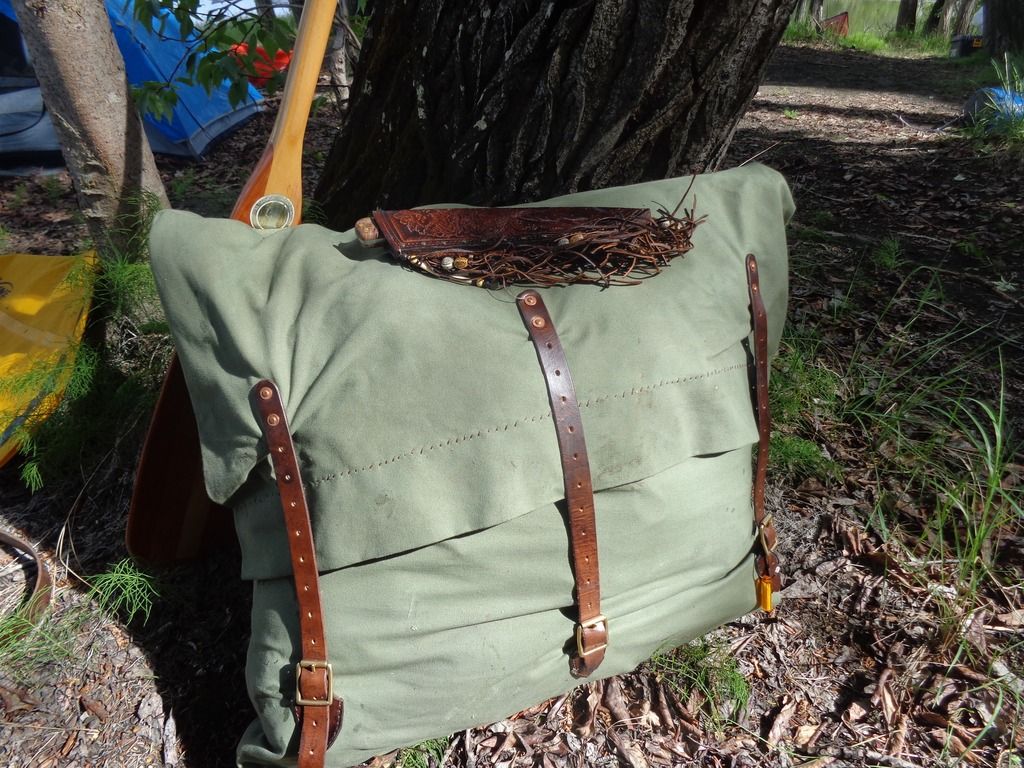
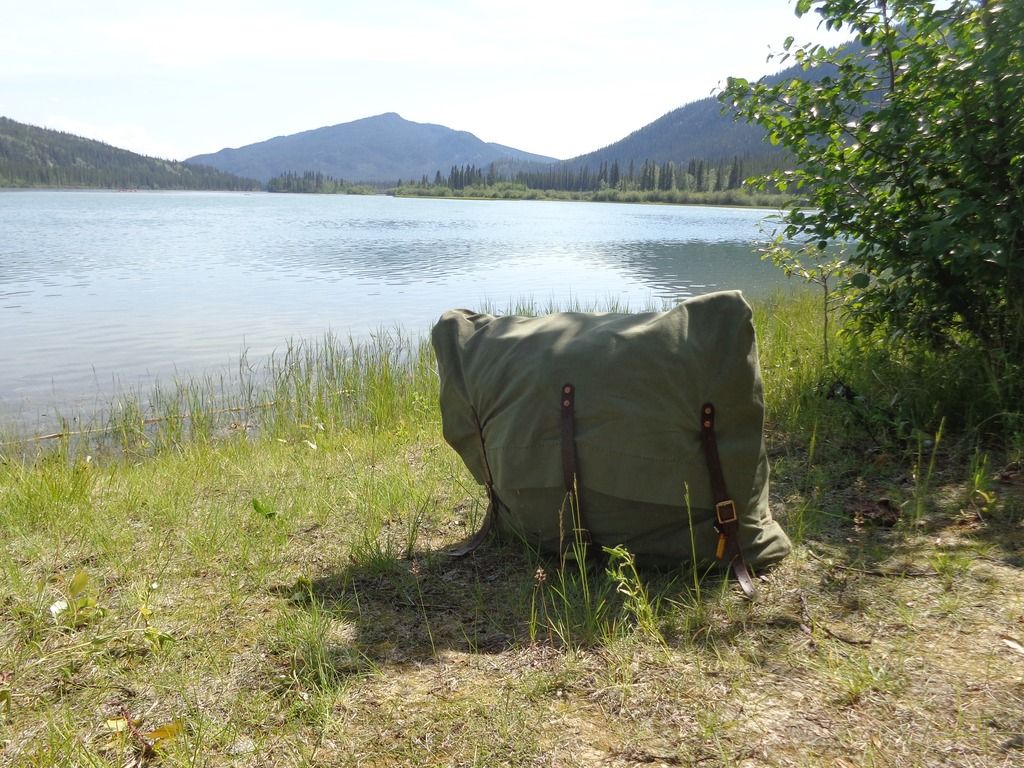
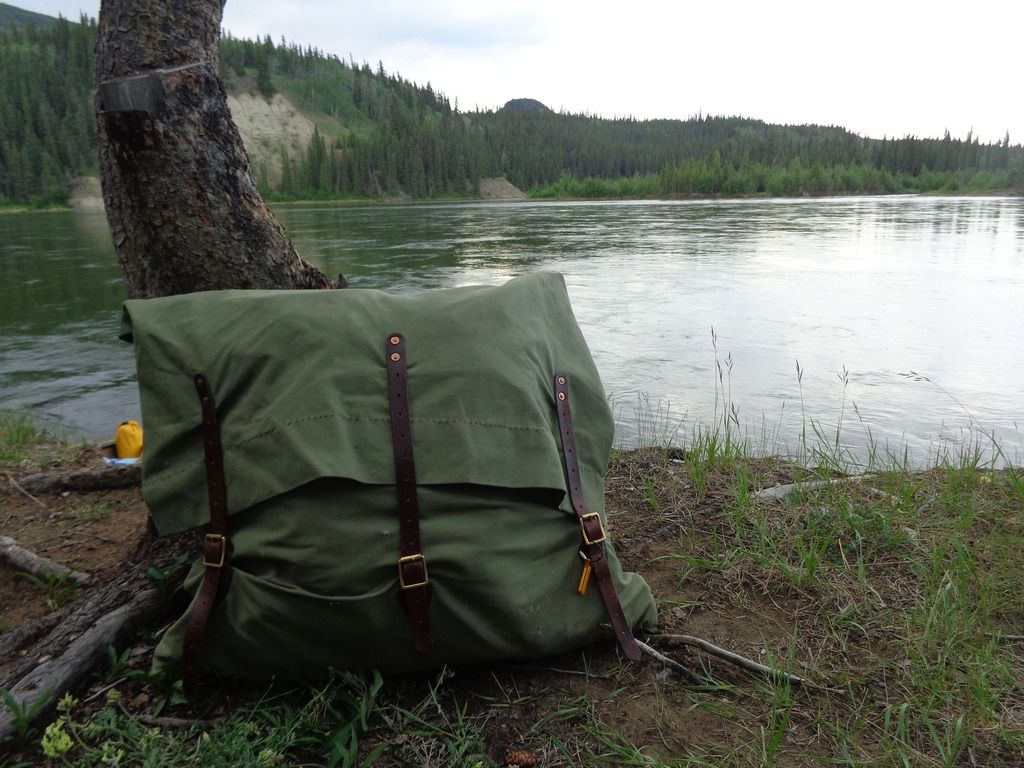
My camp knife started with a hand forged blade in W2 by master blade smith J. Neilson. I handled it in wych elm burl and did a unique pin set up and a indulged myself by making a carved, fringed, beaded, ‘frontier fresh’, pouch sheath.
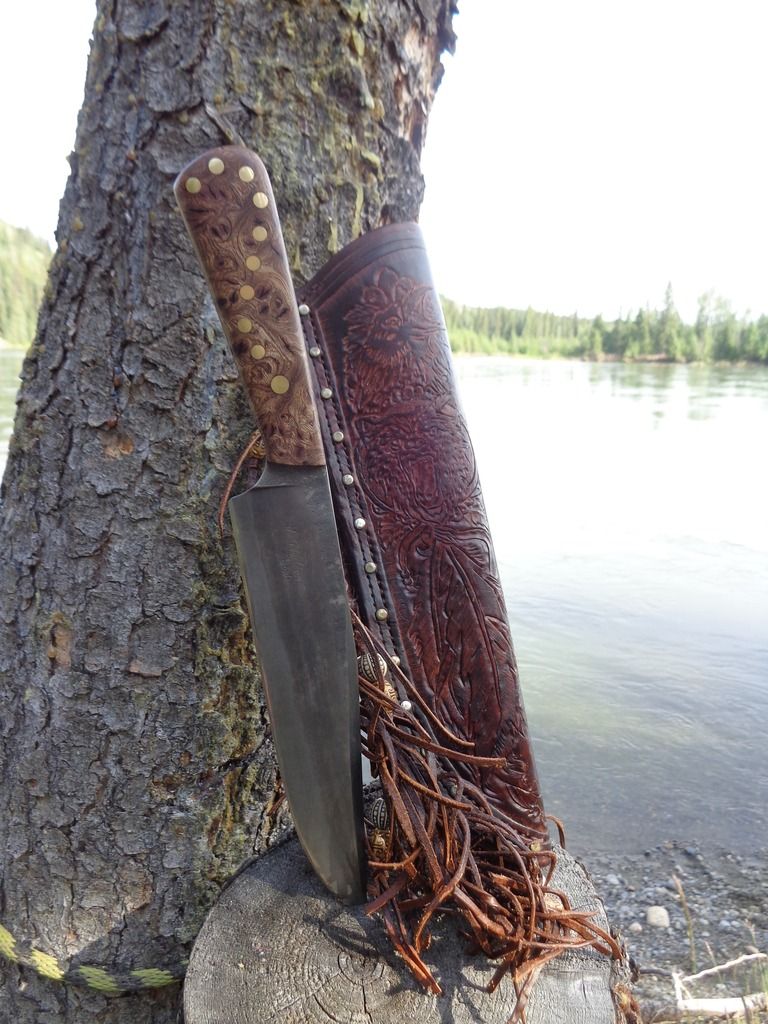
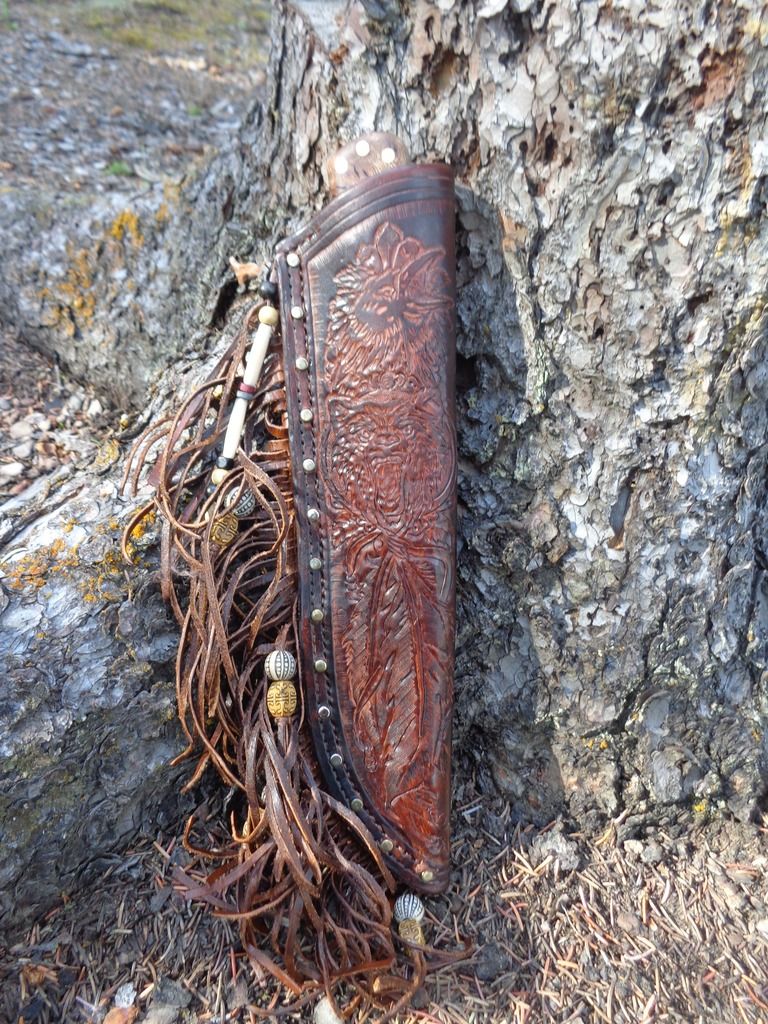
Both proved excellent throughout the trip, but I’ll tell more about these in a separate thread.
It took three flights and a total of 22 hours travelling to get to Whitehorse in the Yukon, but it was worth it. Seeing the scenery on the last plane in made me forget about the jet-lag, for a while anyway.
Fabian and Bob met me at the airport and once I’d collected my canoe-pack from baggage reclaim we headed out to Fabian’s place about an hour outside of town. It was quite late when we arrived, so there was just enough time to pitch the tent and get some rabbit stew before bed - but not before being issued with a can of bear spray and a bear barrel though! All food, suncream, toothpaste and anything else remotely edible to a bear had to be sealed tight each night and left a sensible distance from our tents.
The next morning Bob, Fabian, Kevin and I took a short hike to a nearby viewpoint to talk about the trip, what route we would take, etc. and get a look at the map to get our bearings. Fabian showed us the river guide he would use to help plan where to make camp along the way. It was a useful book and I decided to pick up a copy in the bookstore myself and try follow it along the way. I have to say it was great to know what was coming up ahead in the river and how far we had to make camp. It made finding lunch spots much easier too.
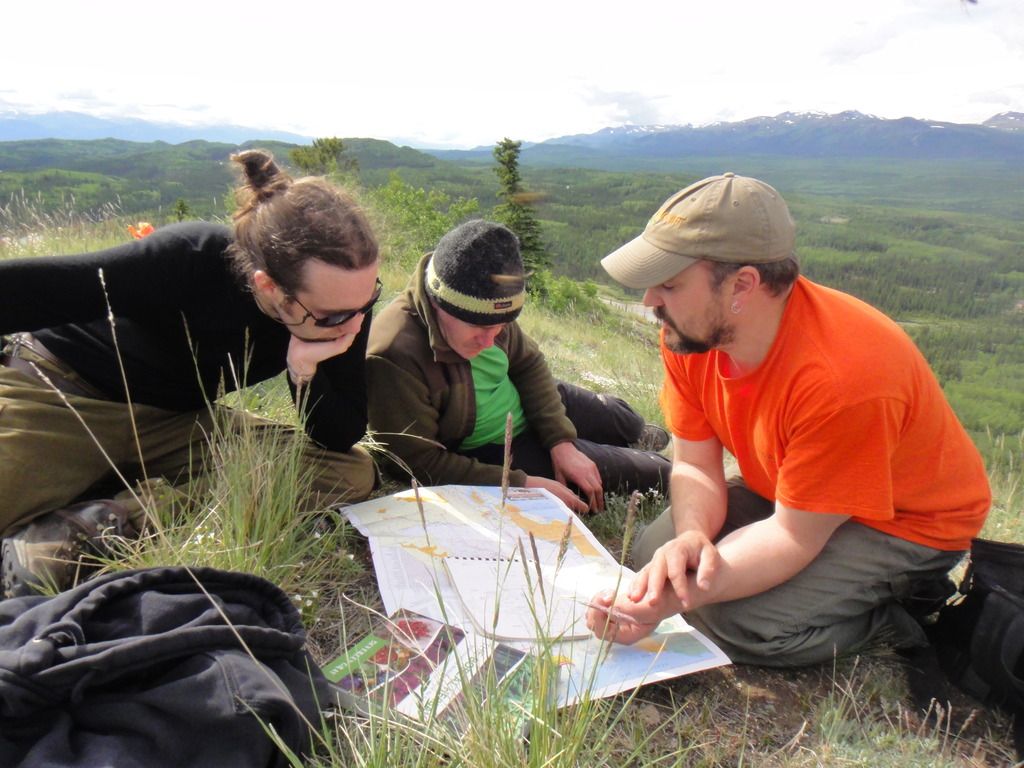
Here is a picture of our route from Johnson's crossing, in the bottom right to Carmacks, a little under 400km.
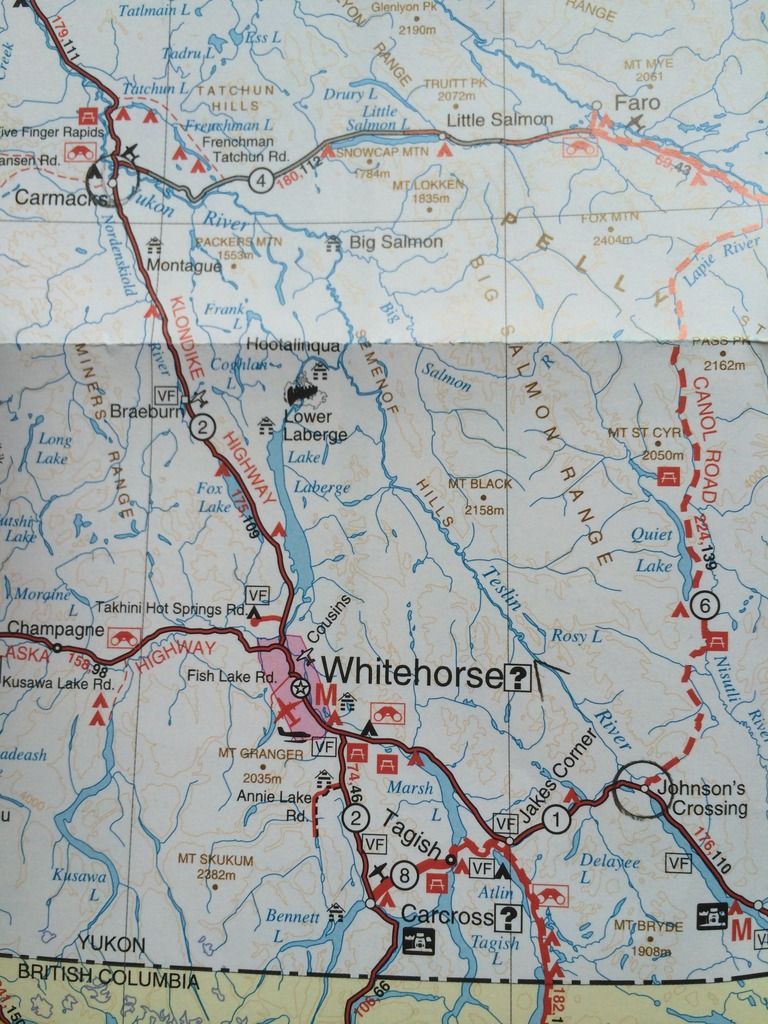
Here you can see the river guide we used as well as some Yukon literature, hunting and fishing licenses and the accompanying manuals. I was very impressed by how the state regulated hunting and fishing. There is clearly a sense of pride and mutual responsibility here that isn't common in many places. For instance, Fabian told me of the harsh penalties one faced if they didn't use all the available meat on a moose kill. Those currently revising policies in Ireland could learn quite a bit from those in the Yukon.
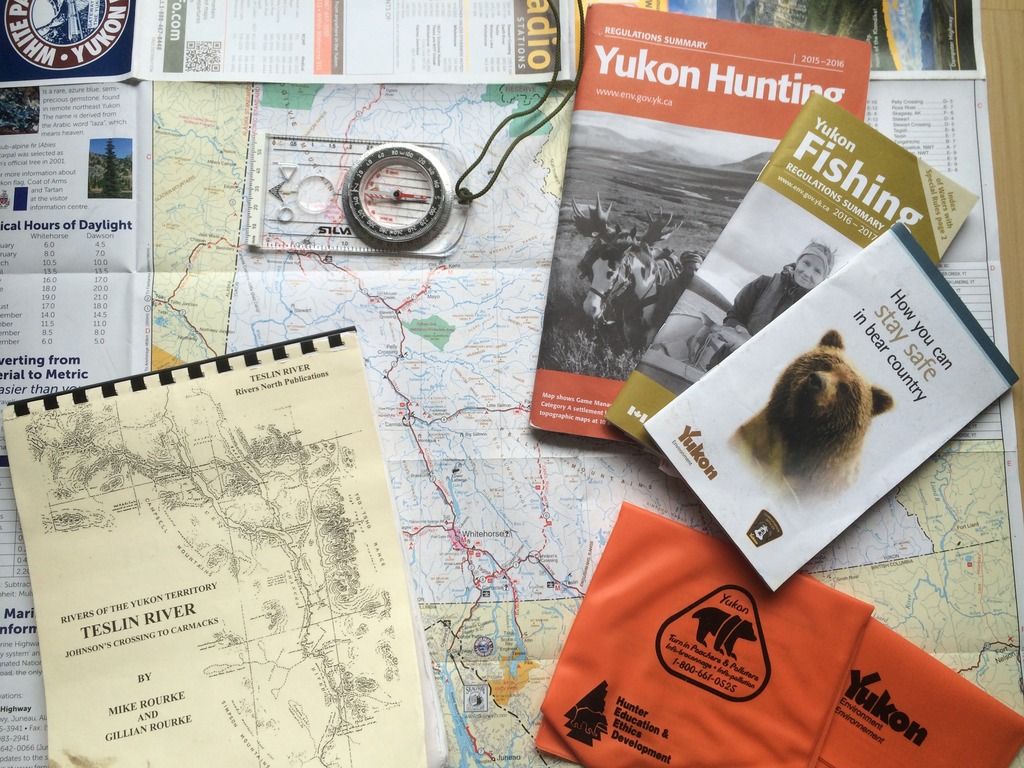
The day after our scenic planning meeting we packed up our gear and loaded the van and trailer with food and canoes. We had some time before we hit the river to wander round town and pick up last minute items, hunting and fishing licenses.
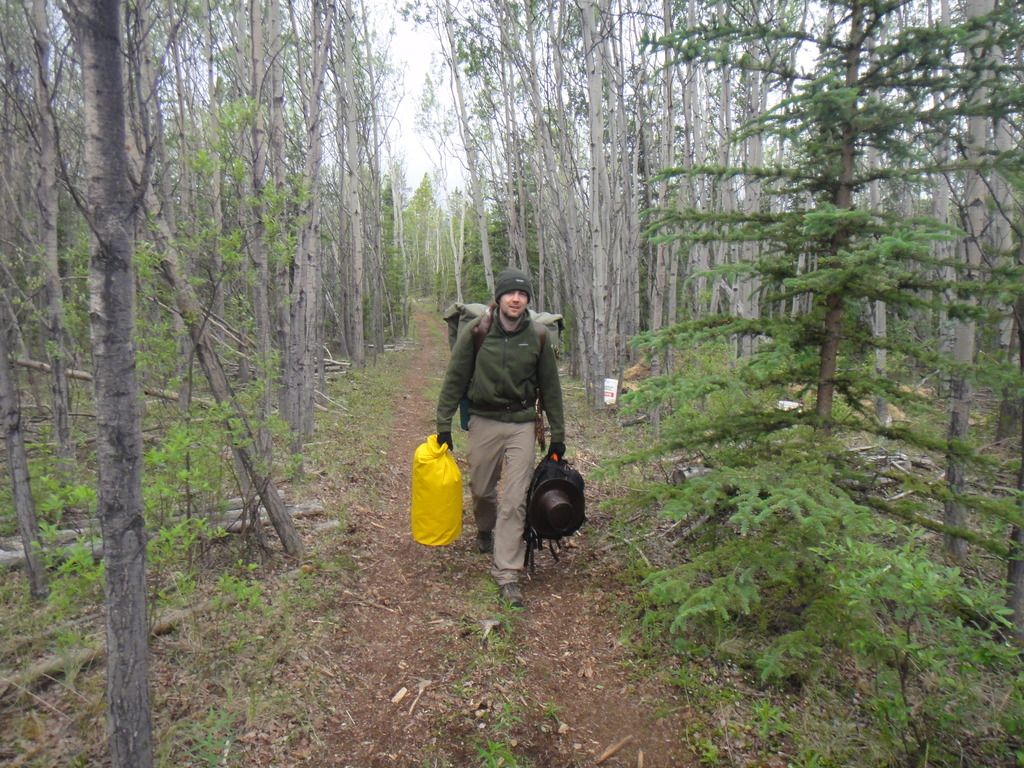
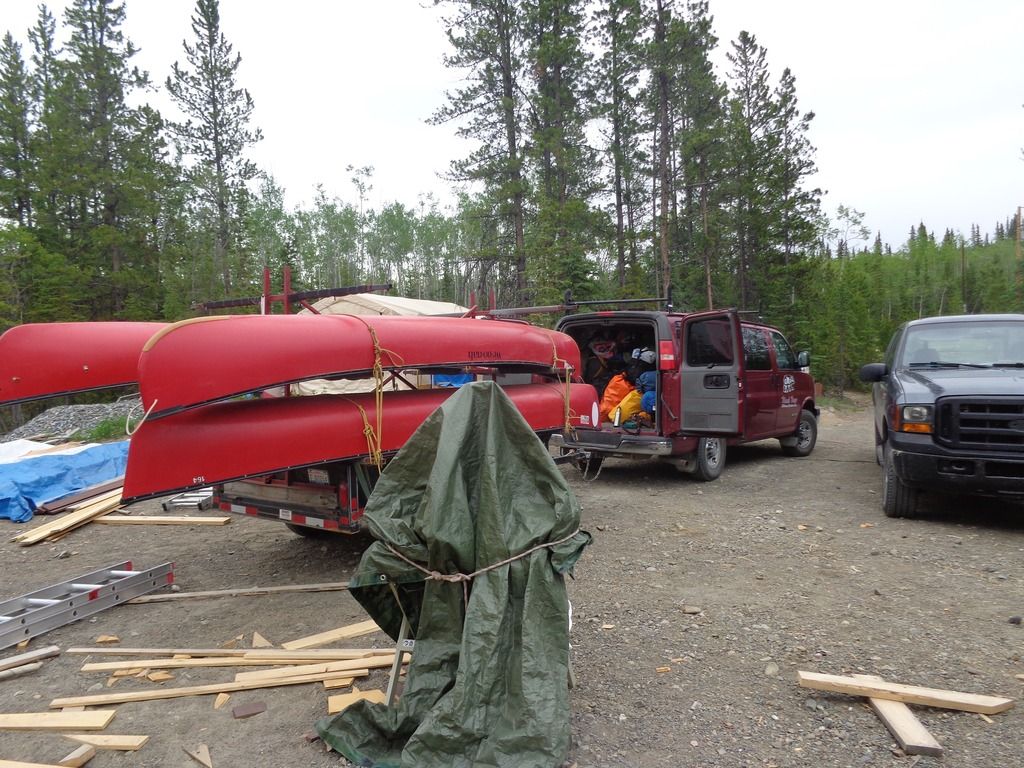

The first day at Fabian’s, it was decided (while I was sleeping off the jet-lag) to take three canoes between 4 of us. So I got a nice surprise when I was volunteered to paddle solo on the first day when we were loading the boats at Johnson’s crossing. It also meant we had room to bring Clein, Fabian’s Alaskan Husky - who was great company on the trip, even if she did make me miss my dog even more.
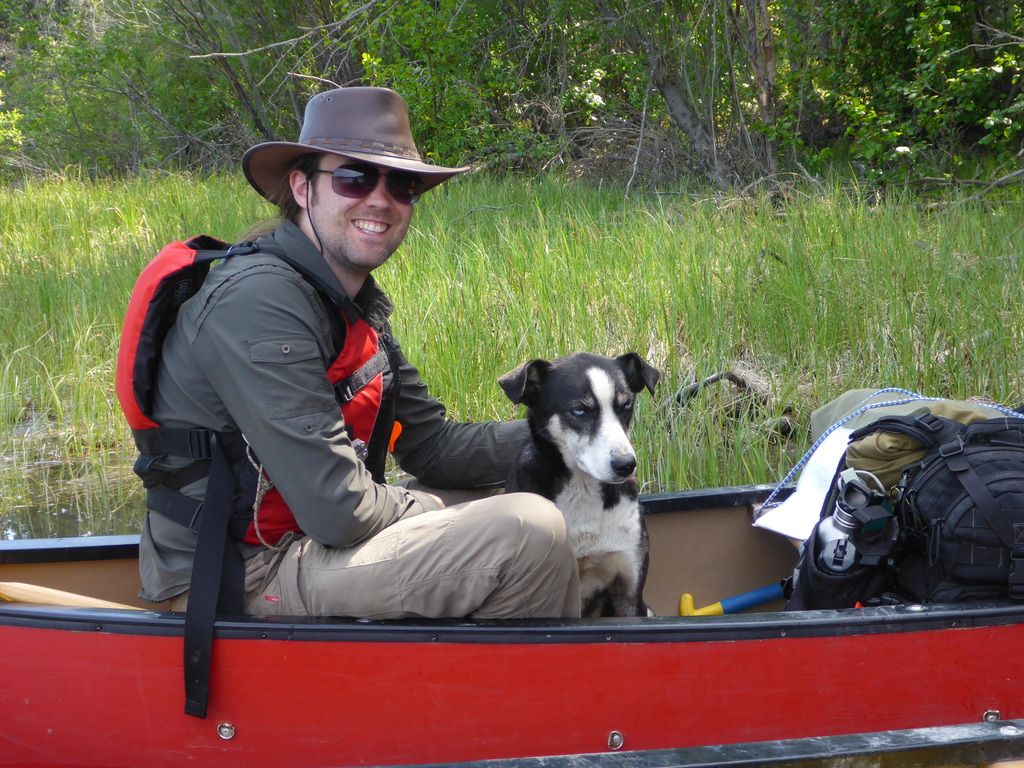
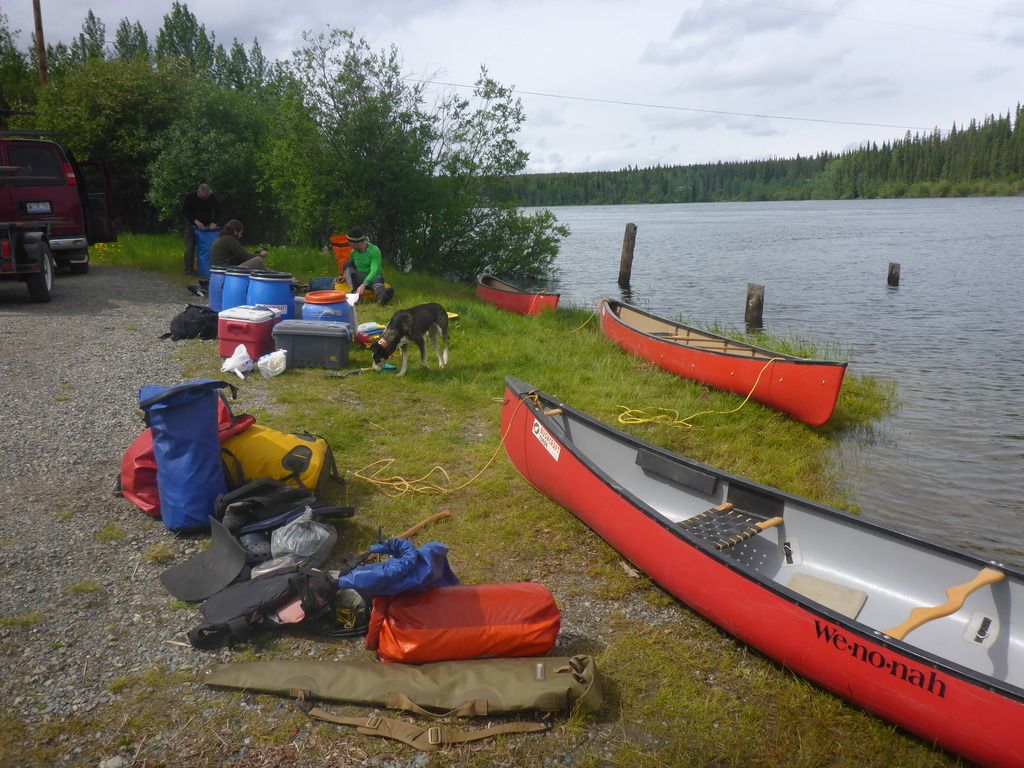
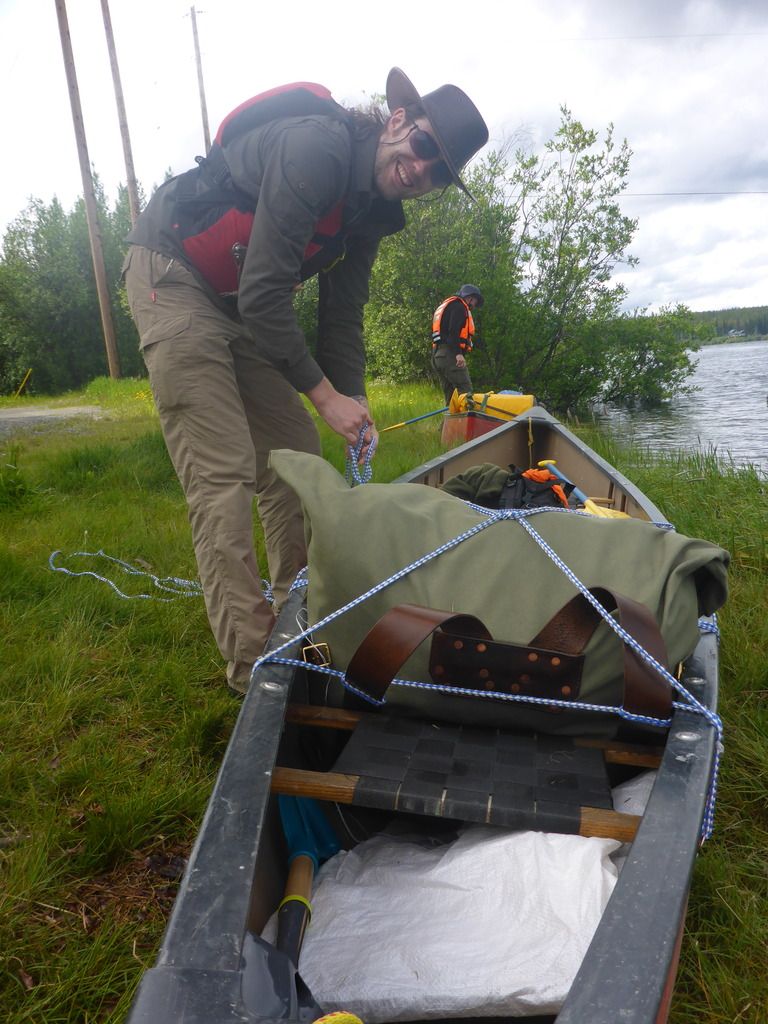
It was tough to keep up with the harsh head winds and I was pretty tired by the end of the first day, as was everyone else. We were slow to empty the canoes on day one before we chose our sites and pitched tents a sensible distance from where we cooked and kept our food. The following morning we were very slow to pack up and get moving. However, as the trip progressed we fell into routine and we were usually up around 7 and had everything packed and on the river by 9.30. In good conditions we made camp in the evening’s around 4 after taking a brief lunch break during the day, but the first few days were far from ideal conditions.
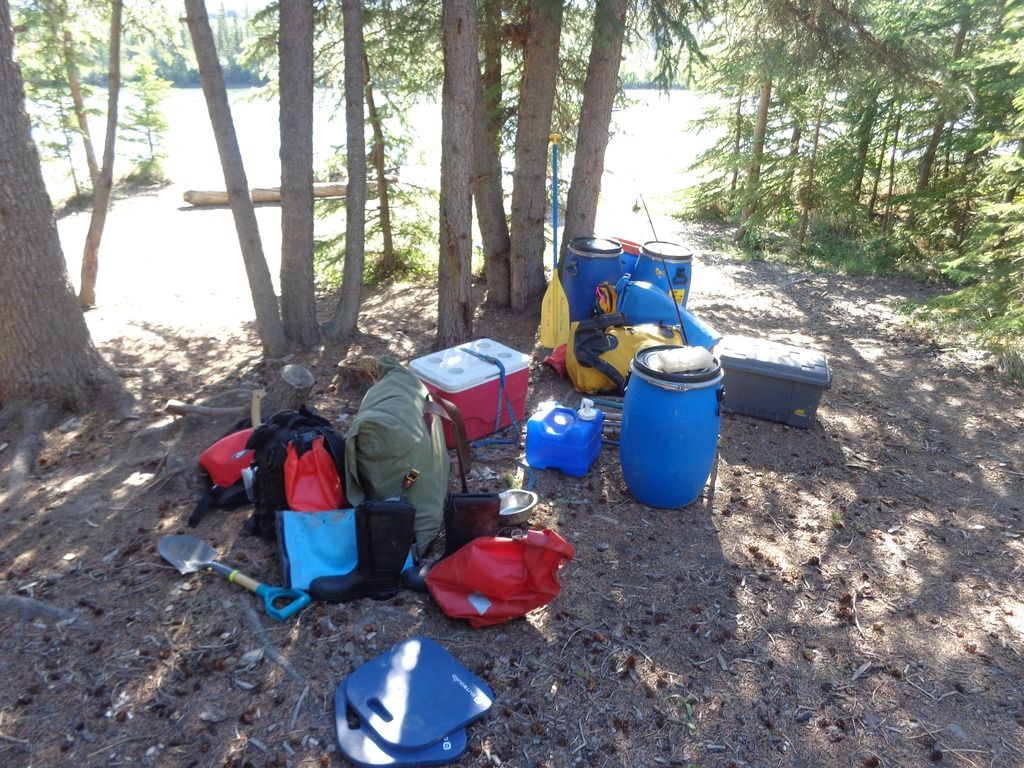
This was one of my favourite camp sites:
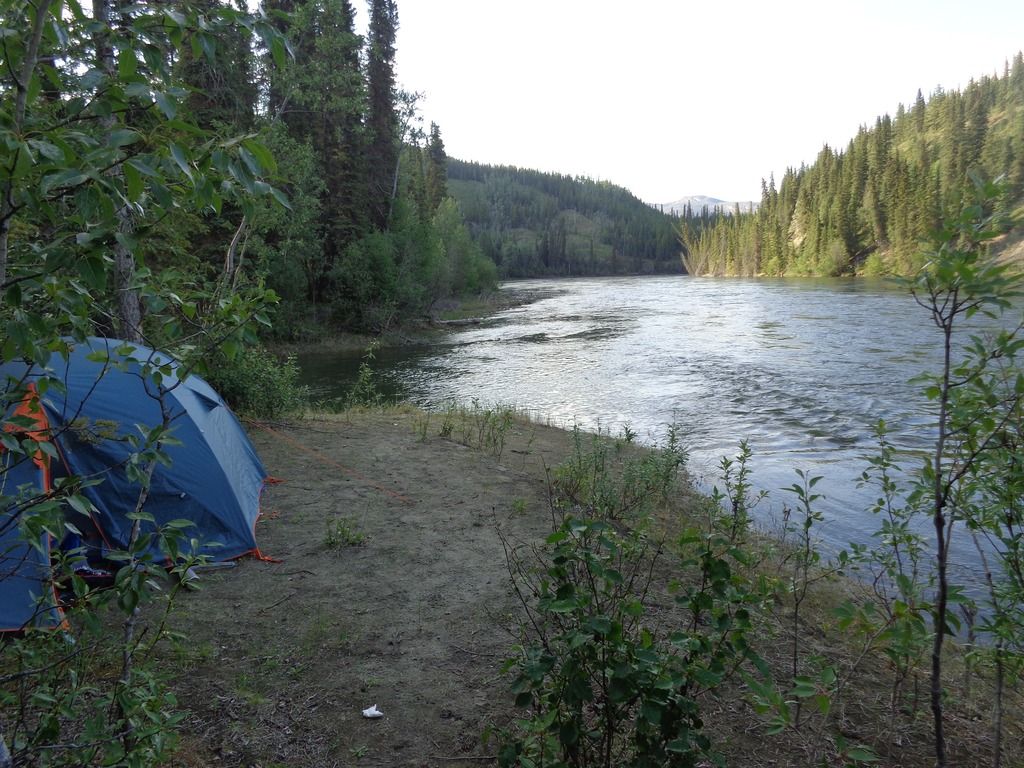
We started off with two days of brutal headwinds that made paddling even tougher for us three novices. By day three we decided to make a three-canoe raft to help us overcome the now 3 foot high, white tipped waves that were pushing up stream. However, it still wasn’t enough and when we stopped to take a picture of a moose, the now 30 mph headwinds pushed us upstream faster than we had been paddling downstream - a measly 2kph! We were forced to take refuge in a small creek to try wait out the fierce winds. It looked like the perfect spot for pike, but nothing was biting that day. We made a quick fire and put some tea on and took a well deserved rest.
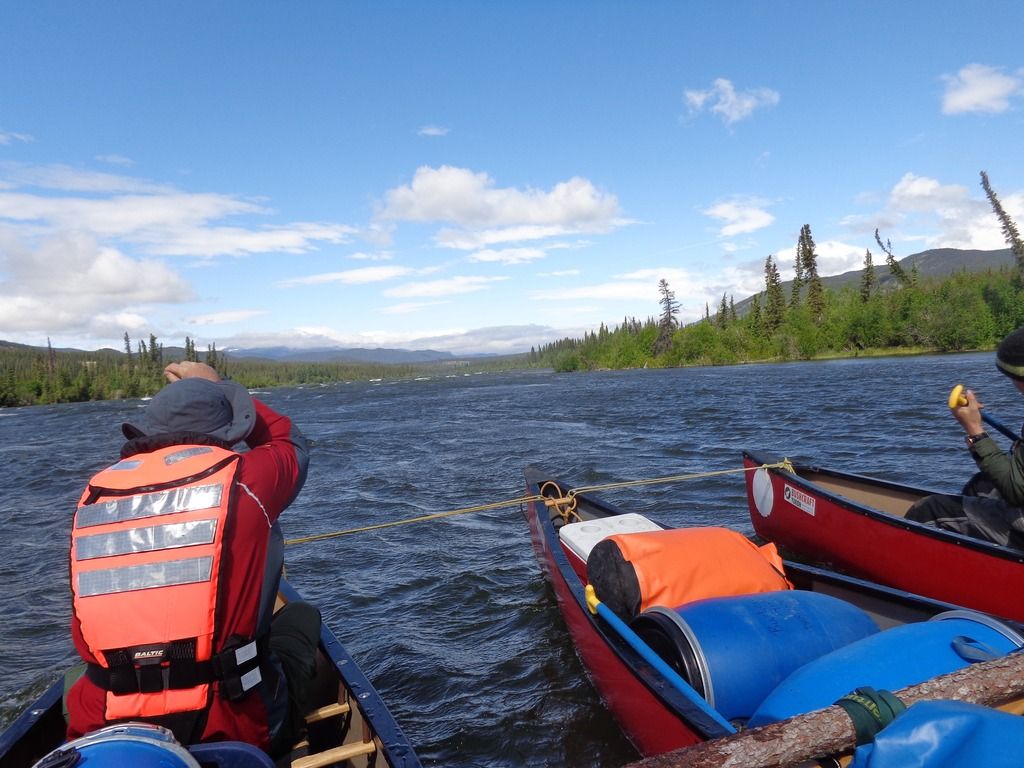
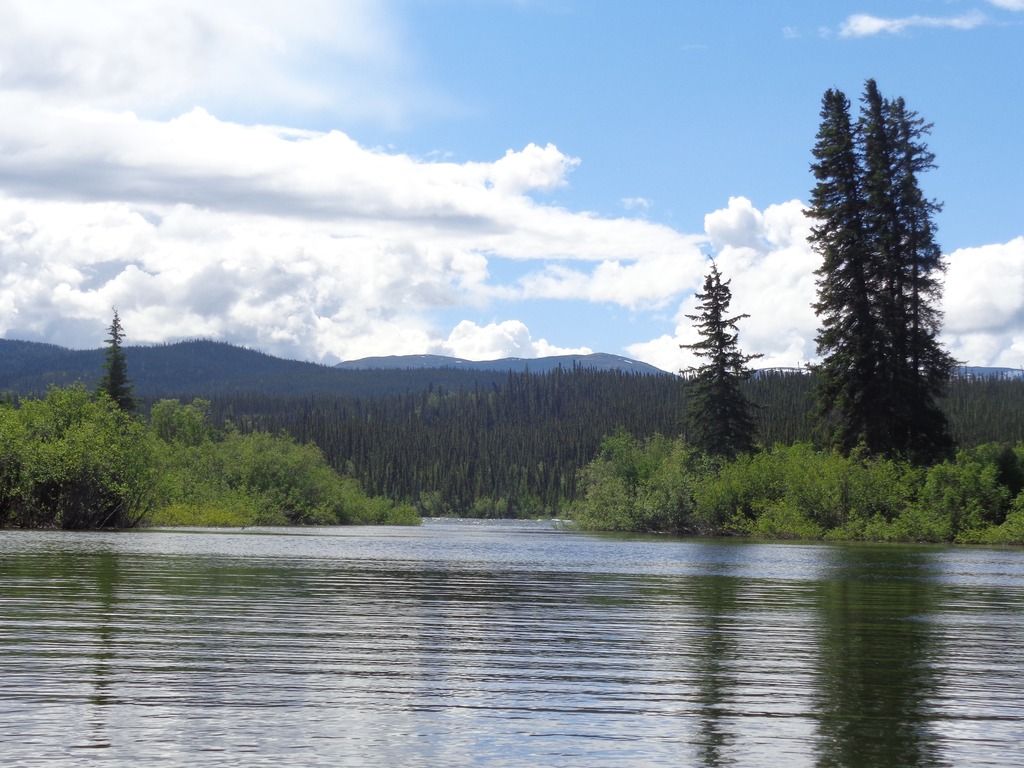
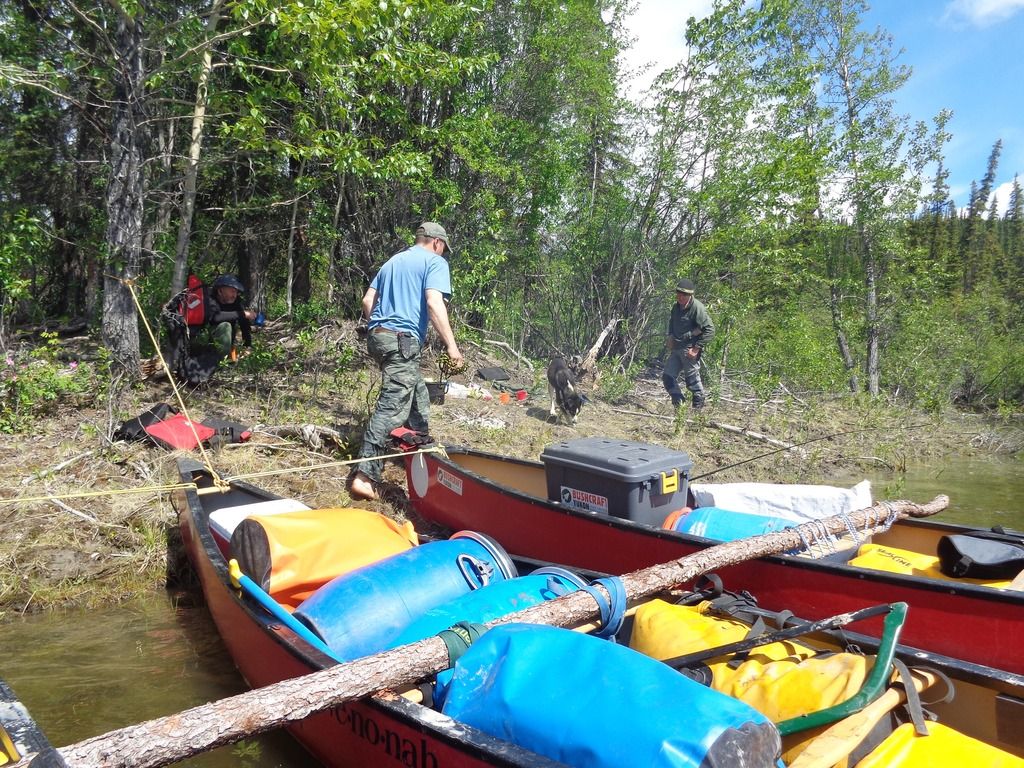
It was so bad on these first three days that there was talk of changing our take-out point to Little Salmon, since it seemed as though we would get no further no matter how hard we paddled. After a few hours, there was no change so we decided to brave the wind again. We didn’t get far before a thunder storm came in. We took refuge in a small, well hidden camp and decided to cook dinner there and hope the weather would break so we could get a few more miles in before the day was out. Things did ease up a little, and that was the last evening we faced such punishing winds on our trip. However, the extra day we had scheduled for a two-day camp and some longer bushcraft activities had been lost due to the slow progress.
On the bright side, we still had enough time to get to Carmacks in time and paddling for the rest of the trip was a breeze compared to those first three days.
For the rest of the trip we had a mix of the three-canoe raft, a two-canoe raft with one solo boat and a tandem with two paddling the raft. The weather was a mix of blazing sunshine, showers and the odd thunder storm. Lightning actually struck quite close to the boat when I was by the river one day, but overall I think we were very lucky with the weather - we got all the bad stuff out of the way early.
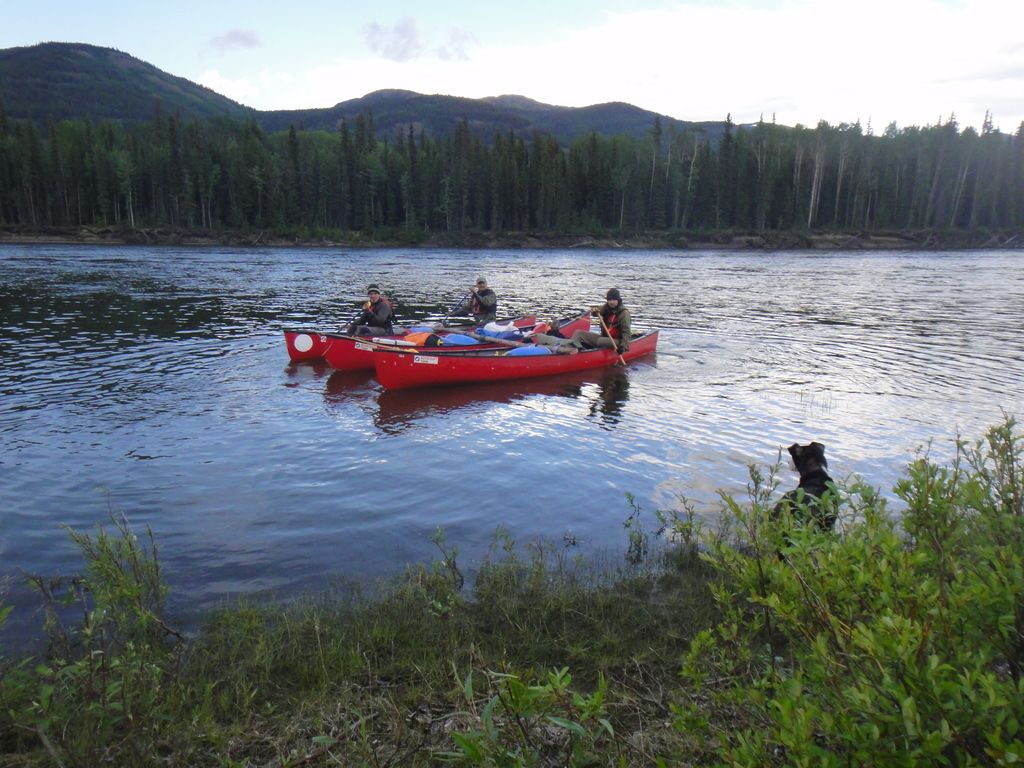


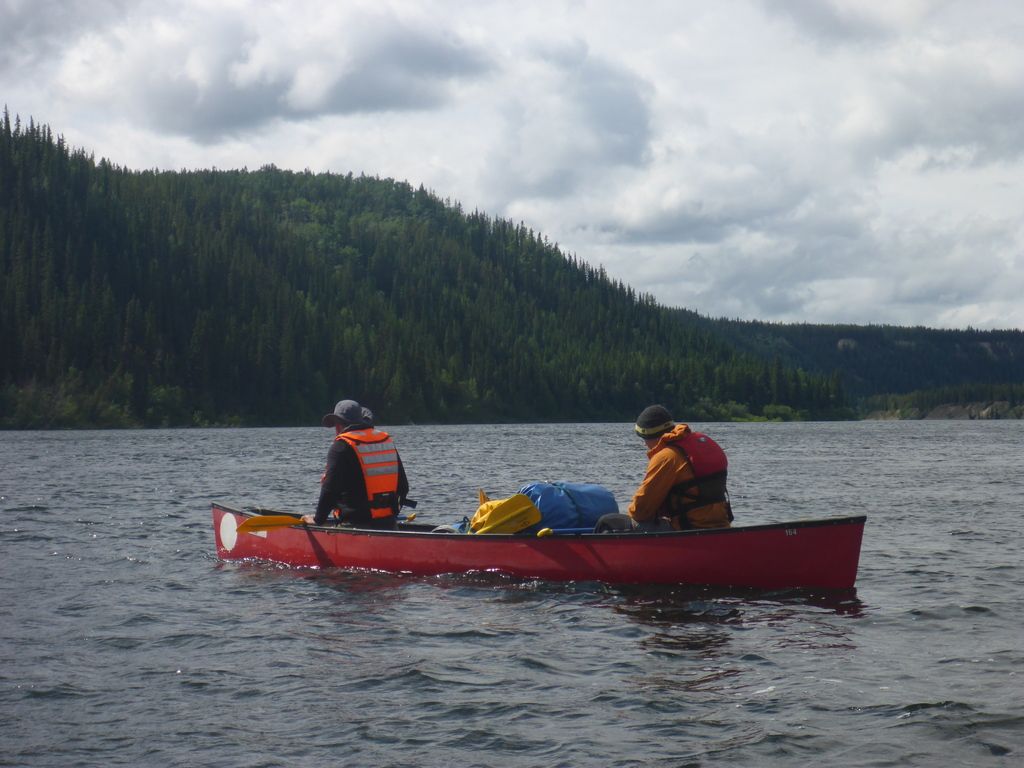
Most days we paddled between 45 and 60 km without ever feeling too tired. The Teslin starts off rather slow, which is great when learning the basics but meant we had to work extra hard at the beginning. As the trip progressed, so too did the speed of the current. Towards the end of the trip it was fast enough for us to make 13 kph just drifting. It was great to sit back, listen to the river and watch the wildlife as we drifted along. It was so peaceful we all fell asleep at one time or another.
Of all the varieties of paddling we did I most enjoyed the days where I got to paddle solo. With the river so quit this early in the season, when paddling in front there were times when I felt like I was the only one there - truly wonderful.

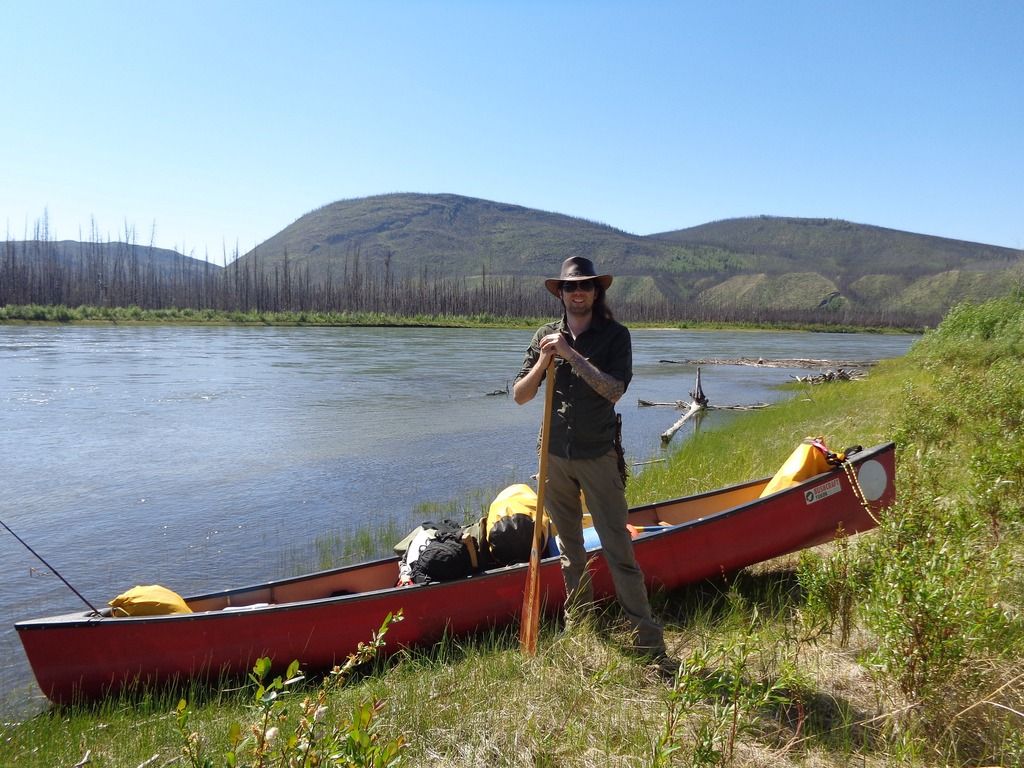

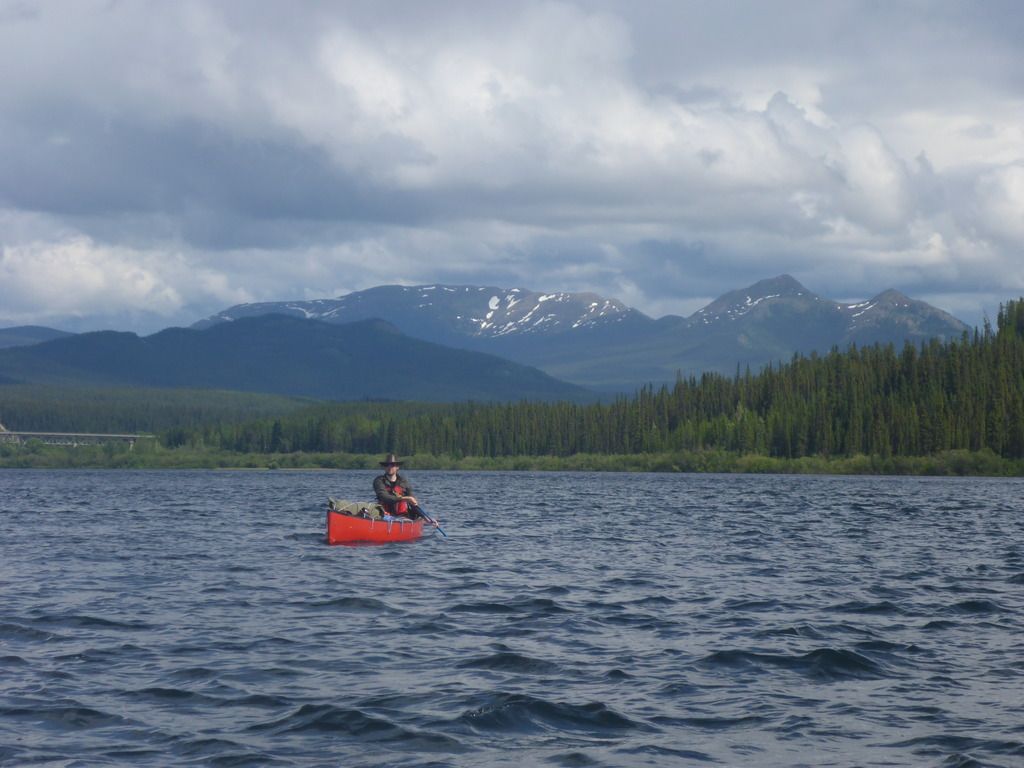
The scenery in the Yukon is truly breathtaking. The rivers are dominated by endless spruce trees, bordered by willows and poplar, broken on most meanders by impressive sand cliffs and Hoodoos. These were great features to use when following the river guide and map, which was great for planning our days and picking camp sites in advance.
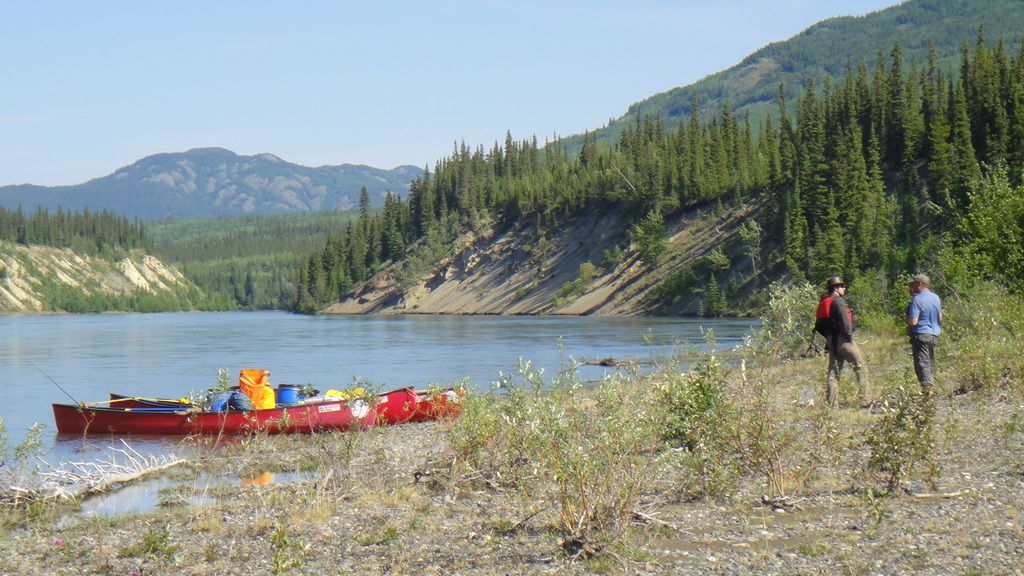
We reached the confluence of the Teslin, Yukon and Thirty-mile rivers at Hootalinqua a little before halfway through our trip. The dramatic change in water colour was striking as the dull brown of the Teslin met with the brilliant turquoise of the Thrity-mile. We went for a short hike up to a view point to get a better look. From here we could really appreciate the beauty and tranquility of our surroundings. All the cameras came out here as it was a great spot for a few pictures.
Fabian picked up a 1:50,000 map of this area in the bookstore before we set off so he did a little workshop on map and compass work here.

There were plenty of cabins along the river in various states of disrepair. At Hootalinqua a conscious effort is being made to preserve those present and the artefacts within.

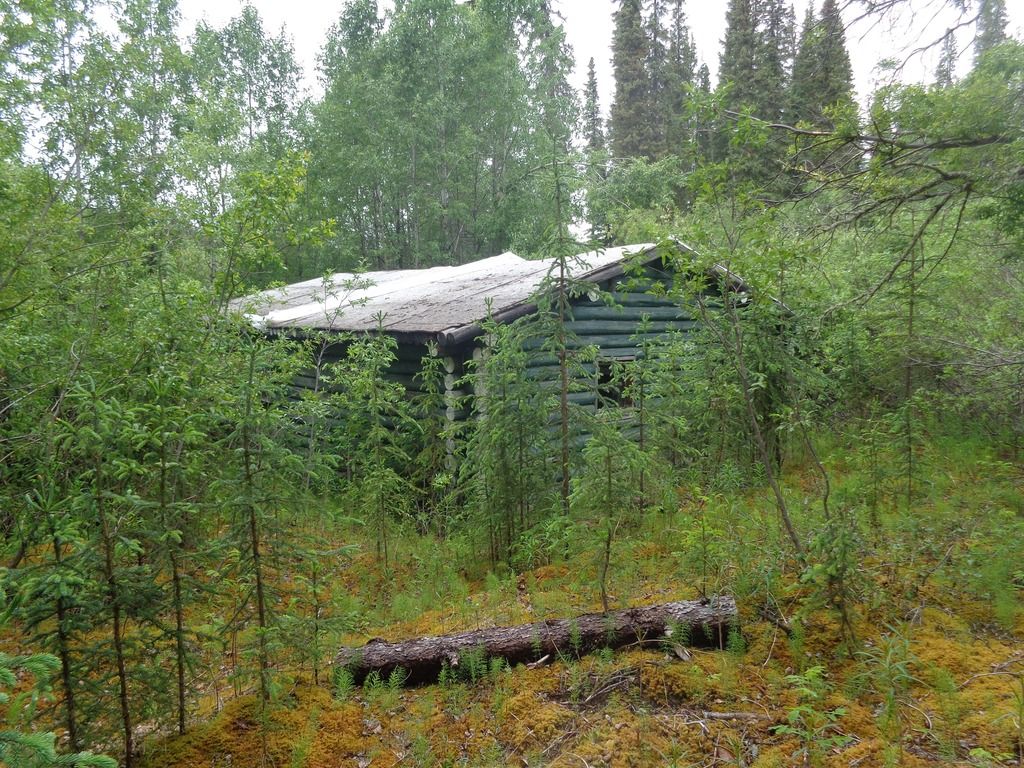
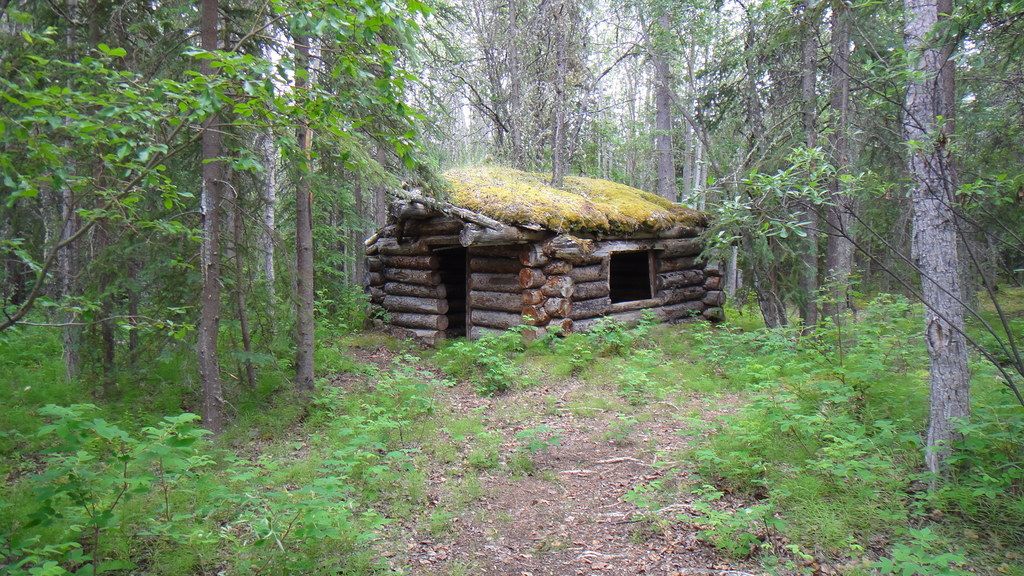
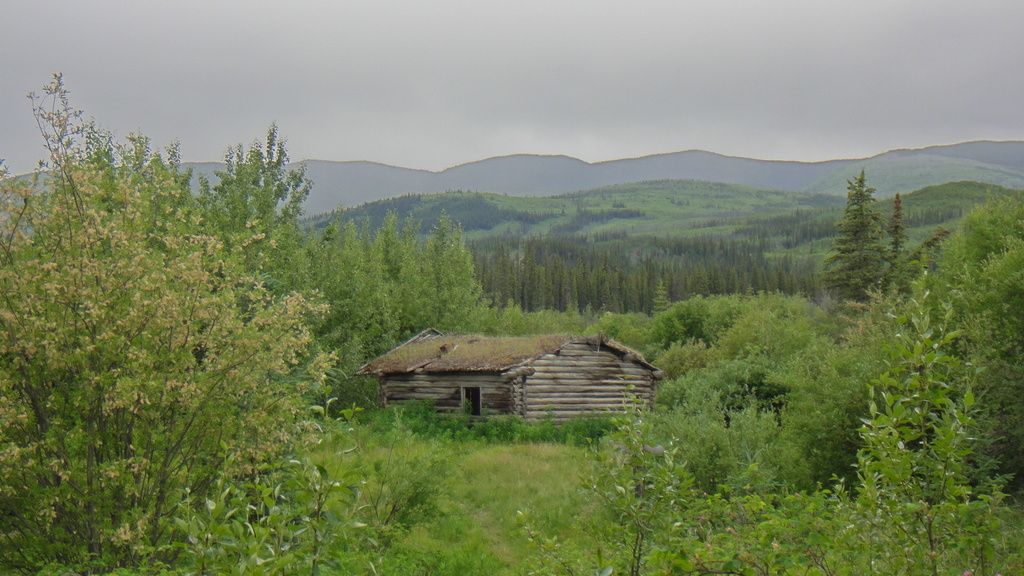
I can’t imagine how difficult it must have been to spend a winter in some of these cabins back when the river was busy with stern wheelers and prospectors streaming down the river in search of their fortunes.
There is an old stern wheeler abandoned on an island at Hootalinqua, which was worth a stop to investigate.
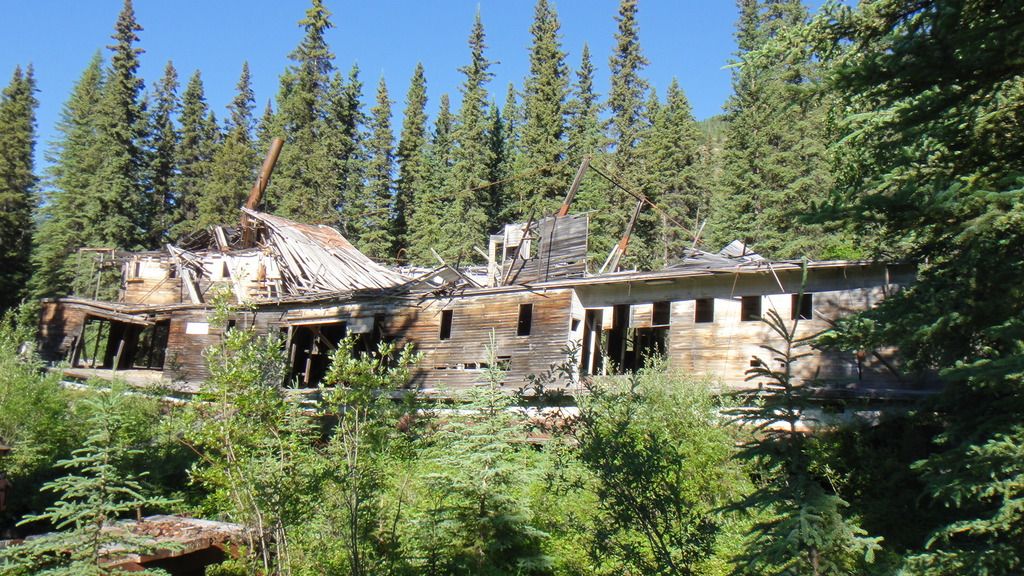
Evidence of the gold rush is everywhere if you stop to look. We saw old water pumps and sluice boxes, as well as an impressive dredge built by two enterprising brothers from an old caterpillar tractor and some spare car parts. They floated it down the river from Whitehorse and staked a claim to a sand bar after being shot at along the way by protective prospectors. Despite raking in 72 ounces of gold dust in just twenty days, they left the dredge behind and never returned. That would be worth $96,264 at todays prices.
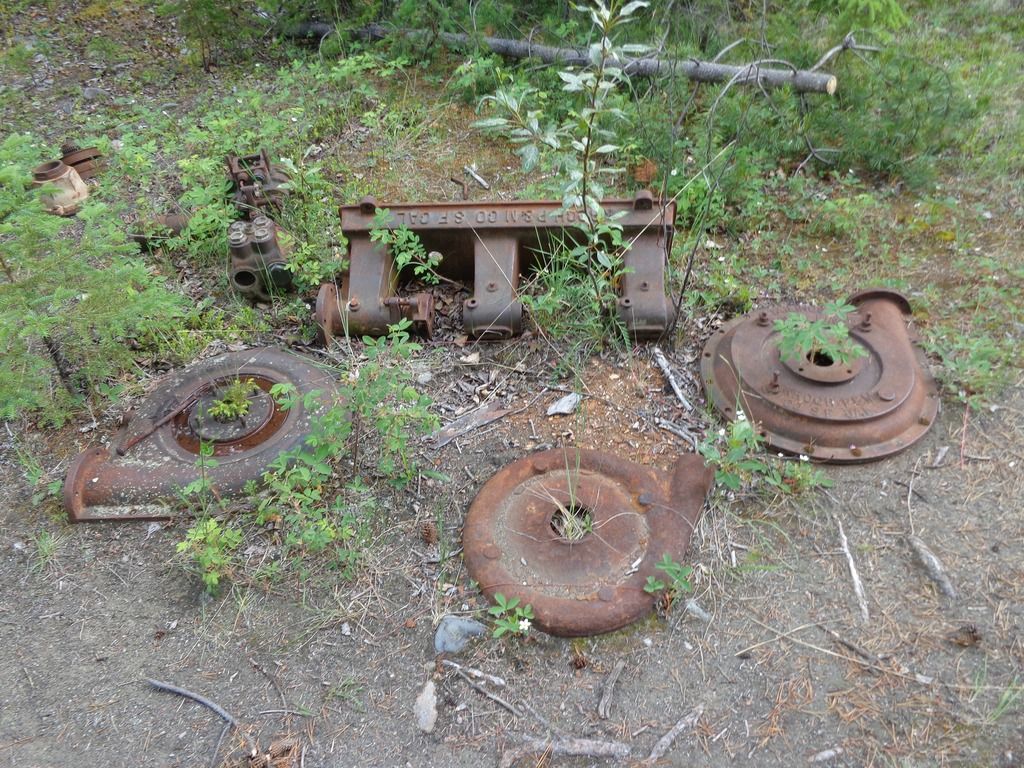
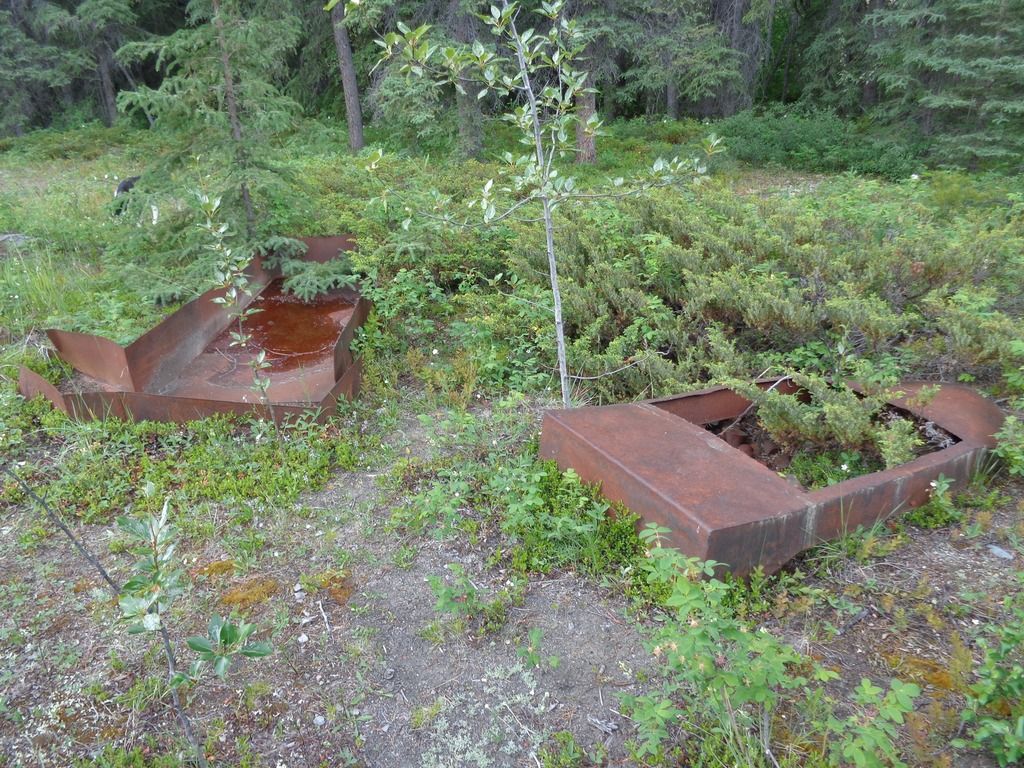
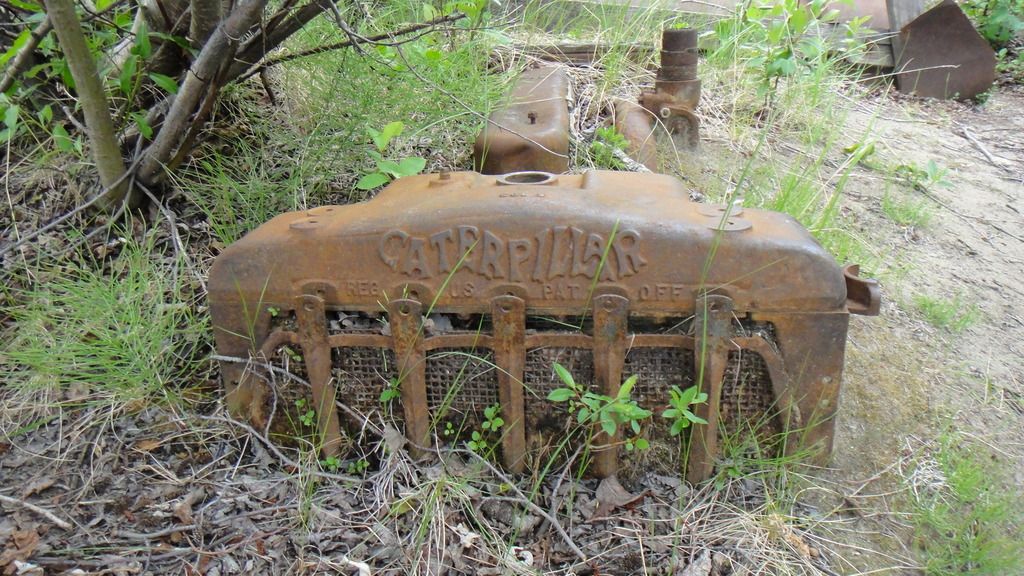
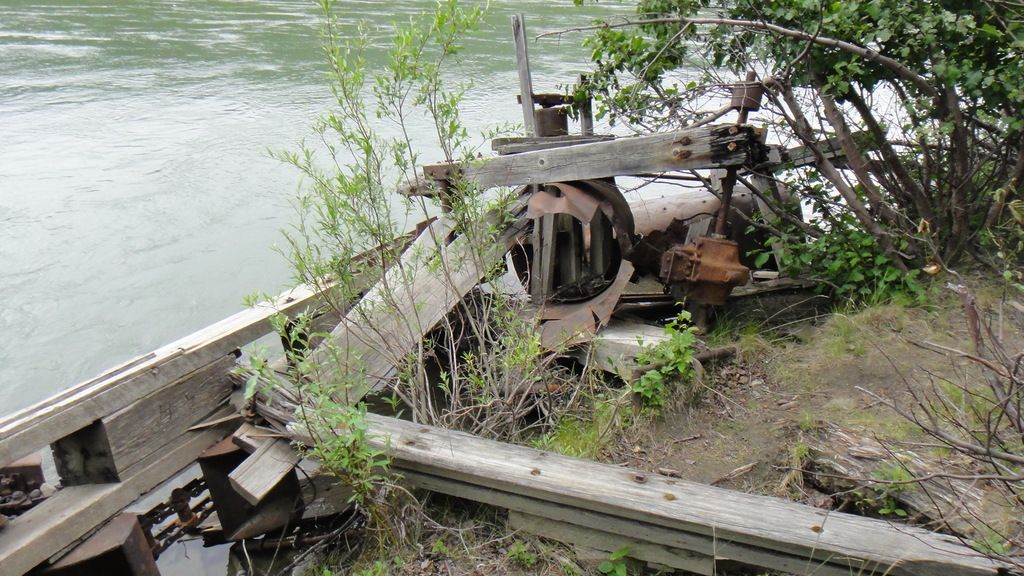

We saw a good variety of wildlife along the way, but the bears never made an appearance.
We saw red squirrels and ground squirrels often and were treated to many moose sitings along the way, getting quite close to some. In each case they were cows with one of two calves in tow.

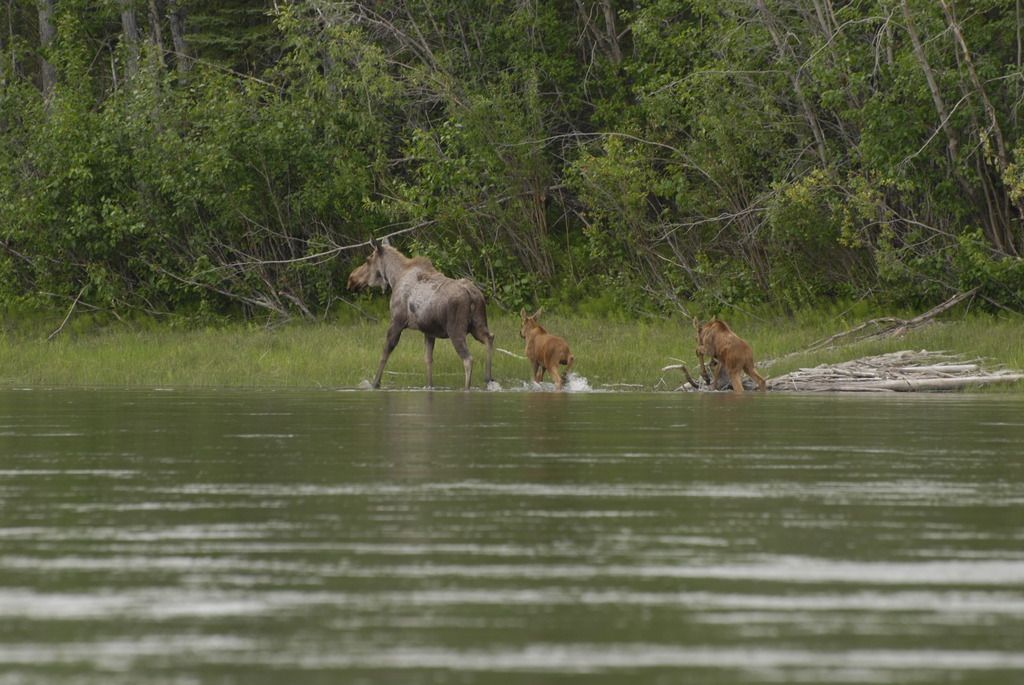
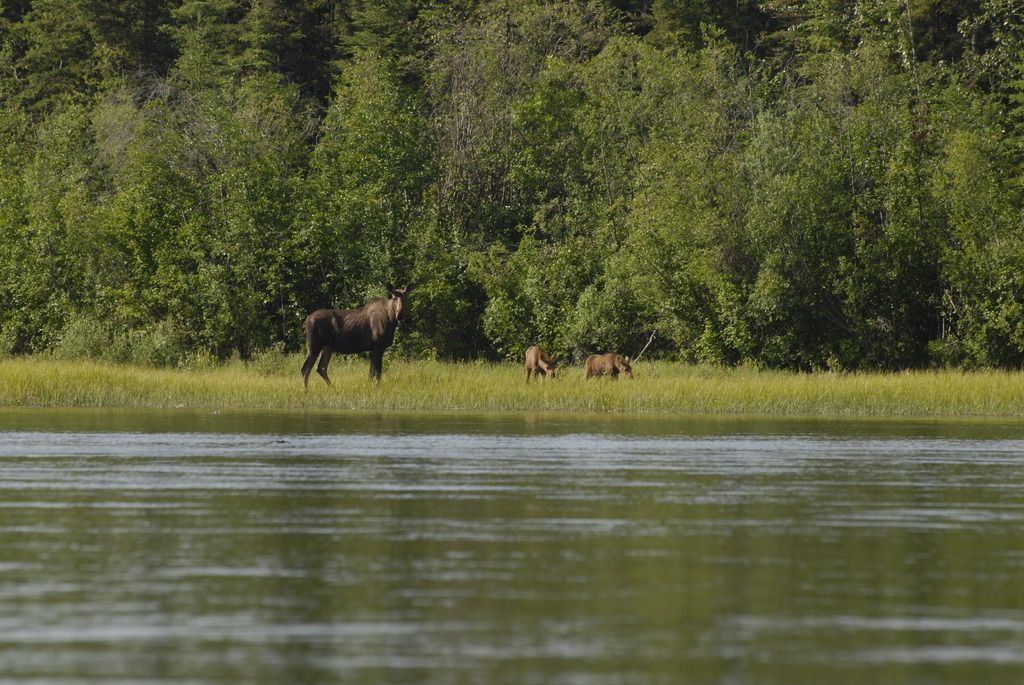
We saw bear scat and tracks, and some grizzly fur where one had been scratching at one of our camps. We also saw alot of moose tracks in some of our camps.
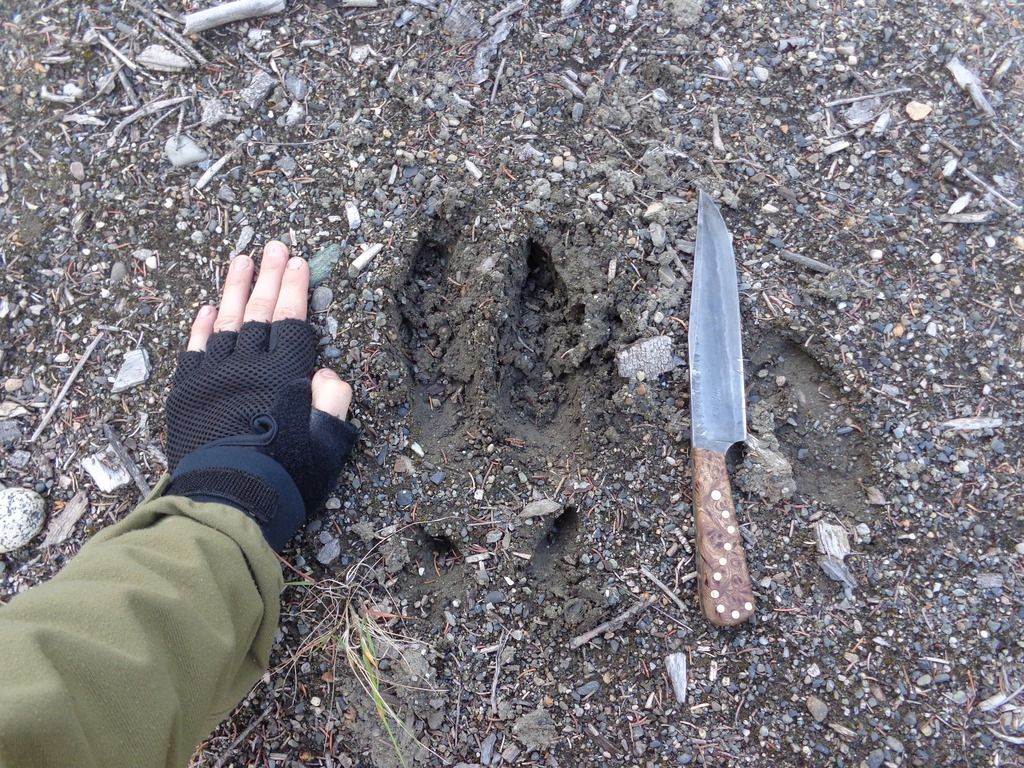
We also saw beavers and a porcupine. We had discussed possibly getting a porcupine before the trip, to supplement our meat as it ran out. When we spotted the porcupine on a sand cliff ambling along we decided to try bag it. A brief explosion of rapid paddling and I jumped out armed with a wooden paddle and ready to bag us two days worth of meat. But hardly half way up the cliff and I heard shouts of ‘someone tie the boat up’! As I looked back to see our raft drifting away I decided to race back and tie it up. Fabian and I tried tracking the porcupine but he went into very thick bush at the top of the cliff and we lost him. It was a little disappointing, but nothing could put a dampener on such a wonderful trip.

Every day we saw bald eagles, even getting a glimpse of a nest one morning after breakfast.

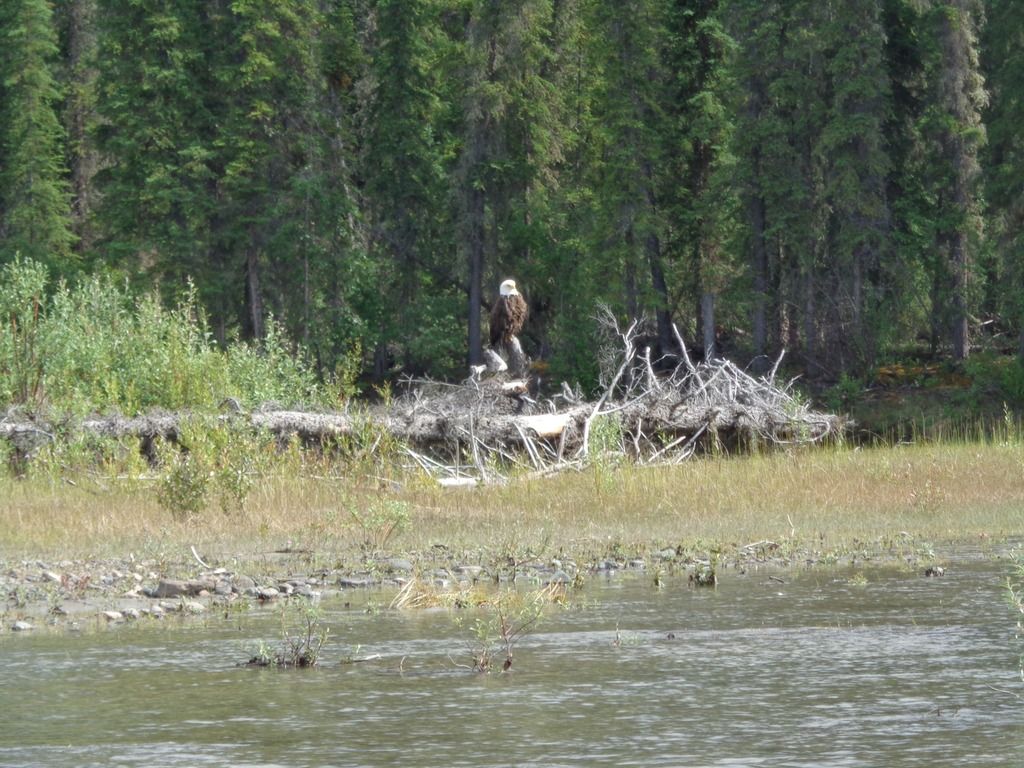
We also saw a couple of hawks along the way and a host of other birds including: various duck varieties, swans, Canadian geese, kingfishers, and loons (the Canadian National bird featured on the one-dollar coin, colloquially known as a ‘looney’

The fishing in the Yukon was great. With Fabian’s expert local knowledge we could easily pick the right spots to bag Arctic grayling and pike along the way. The pike weren’t biting the first few days - probably due to the rough weather making the water a little murky. Half way through the trip I caught a small pike in a pond at Hootalinqua, just in time for dinner and after we ran out of meat too. It wasn’t the best of eating fish due to a slightly murky taste and those damned pike bones, but it was something different and was a good addition to the rice and veg that night.
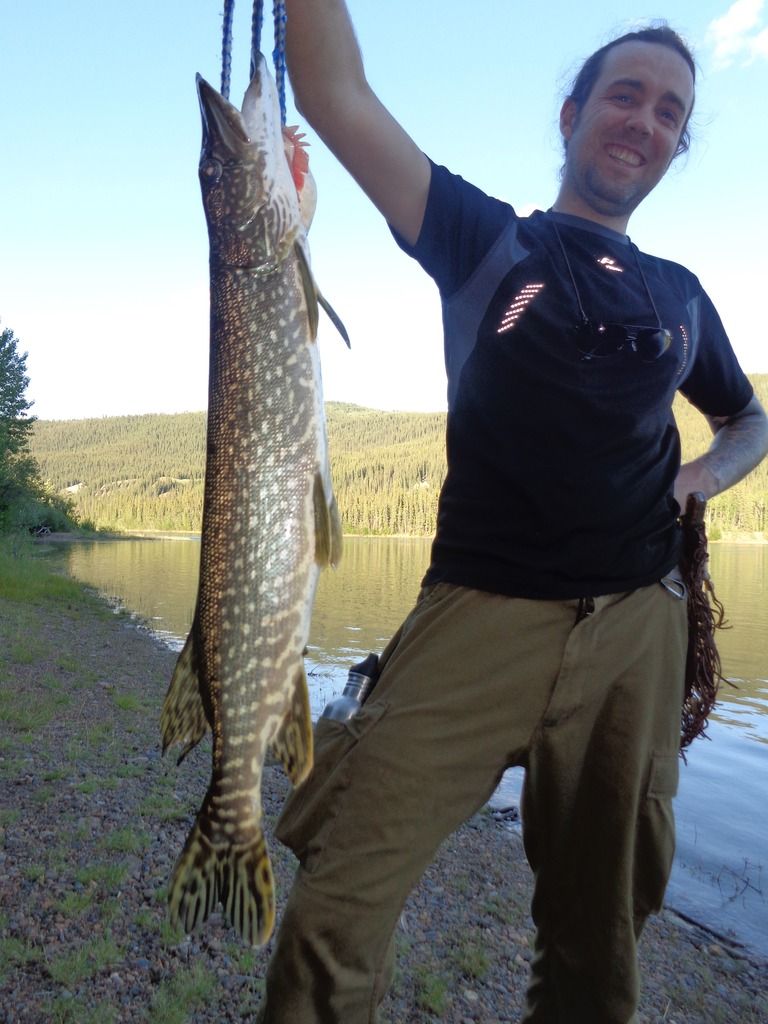
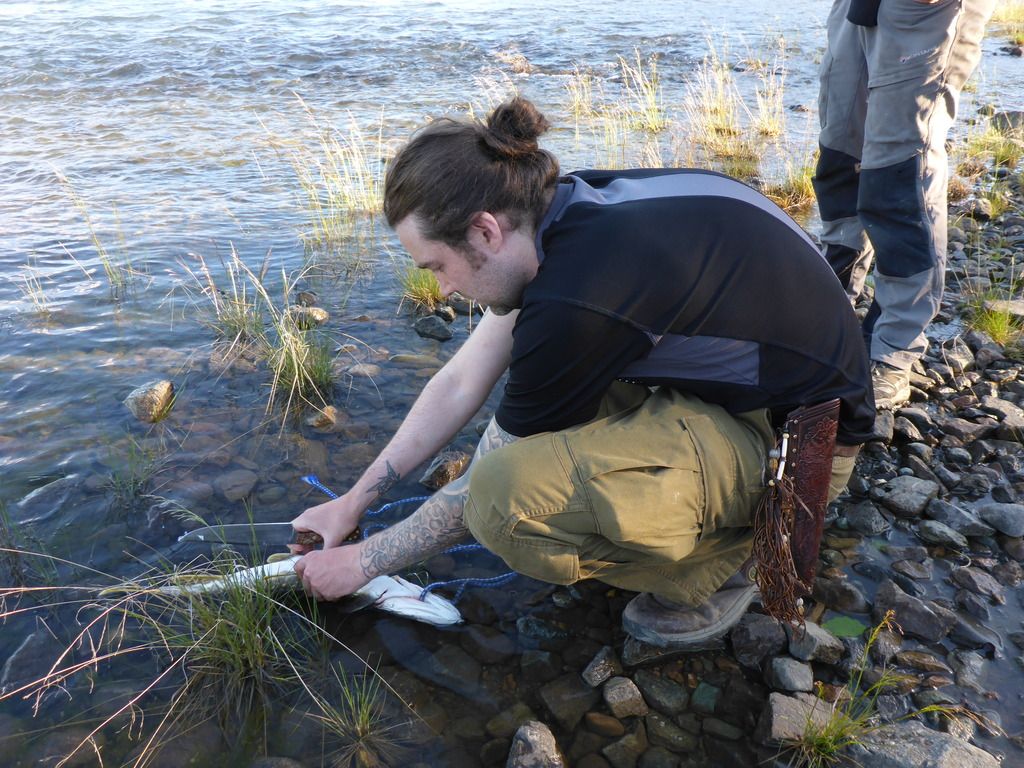
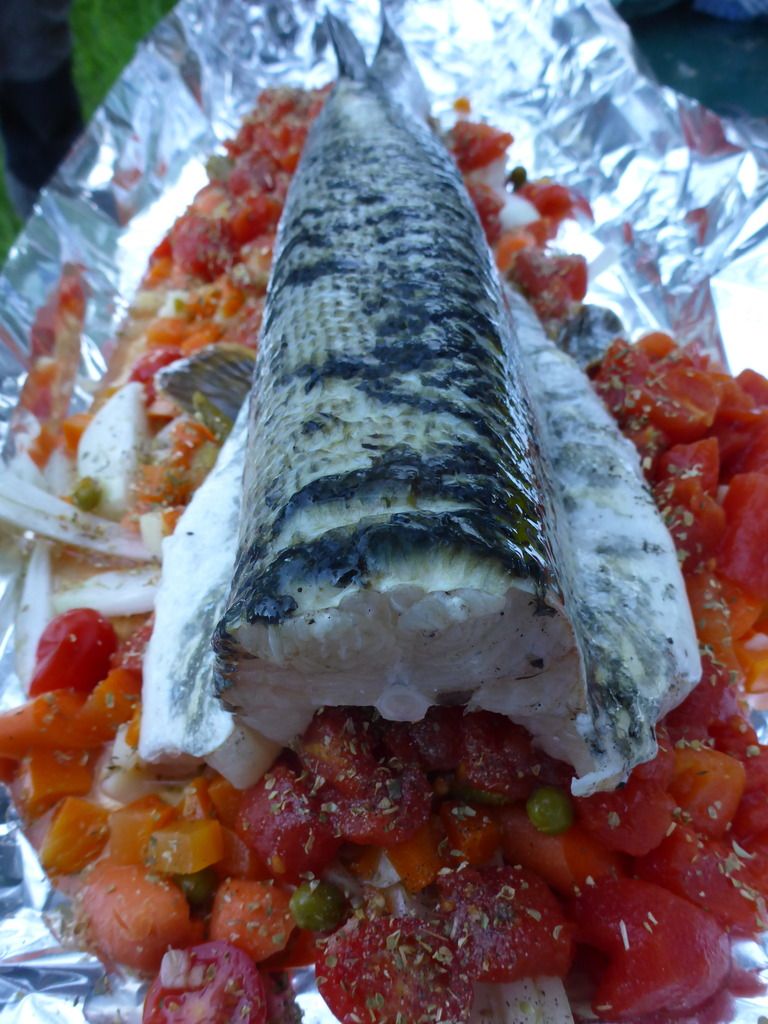
On day three we caught our first grayling of the trip and we had no trouble from then on. It might have something to do with me accidentally sacrificing my binoculars to the river a half hour earlier!

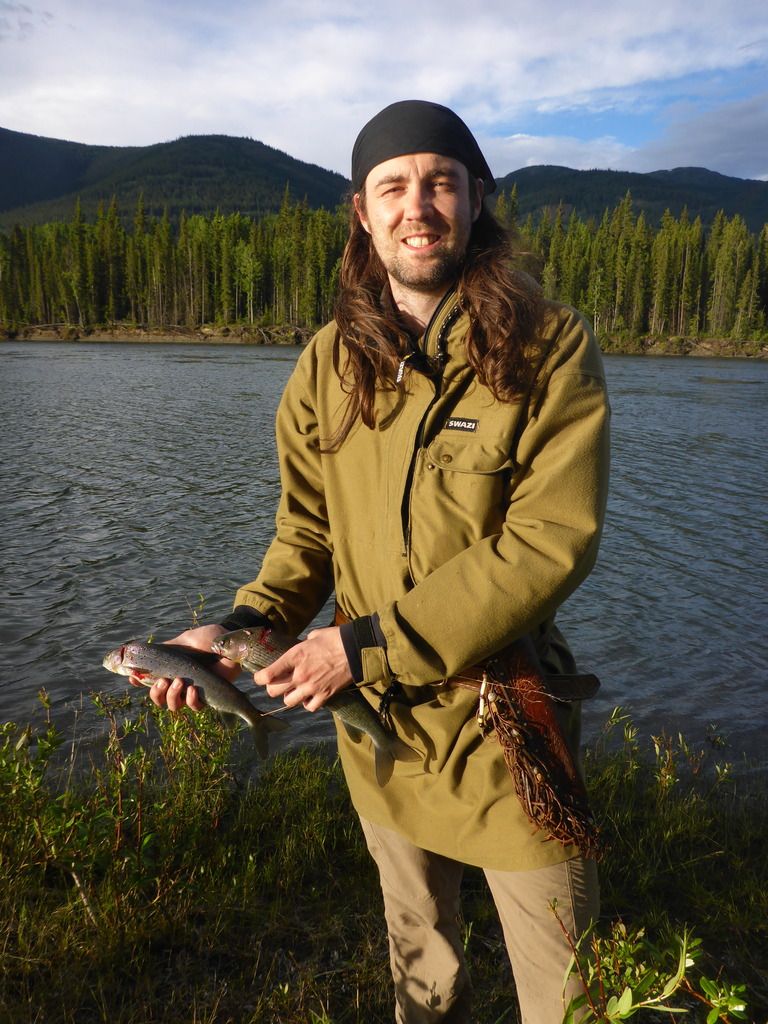

Fabian had the shopping done by the time we got there and he made sure we were well fed along the way, as even after two tough days these smiling faces demonstrate:
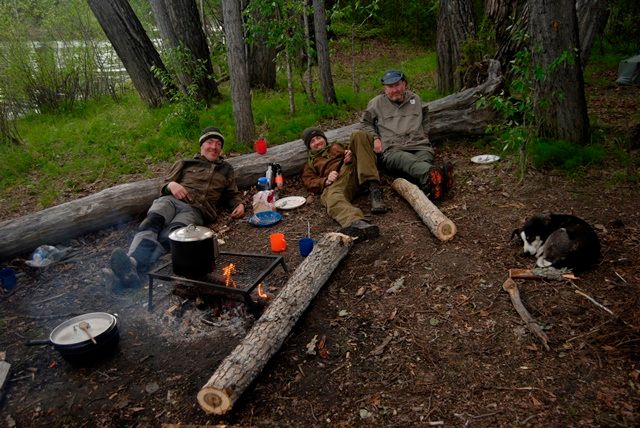
All cooking was done over the fire in the dutch oven. Water was purified using a Katadyn gravity filter or boiled in a pot for tea.
We were shocked to find just how easy it is to light a fire in the Yukon. There is an abundance of dry material for the taking and plenty of dead standing trees to fell. For the most part one needed only collect a few dry, low hanging spruce branches and whip out a lighter. A bit of dry grass from the base of a tree was enough to catch a spark if you preferred a fire-steel and there was old-man’s beard and spruce sap in large quantities if needed. We saw a lot of tinder fungus and sap wood around our camps, but nobody seems to bothers with it up there since it is so easy to make a fire.
We collected, cut and split wood as a group throughout the trip and it worked very well.
There isn’t a great variety of trees, and for the most part spruce was used. It made for a hot, fast burning fire and was fine for our needs. Suitable camp sites along the river banks usually had a small ring of rocks to contain a fire and occasionally a rough bench or table of logs thrown together by fishermen using them regularly.
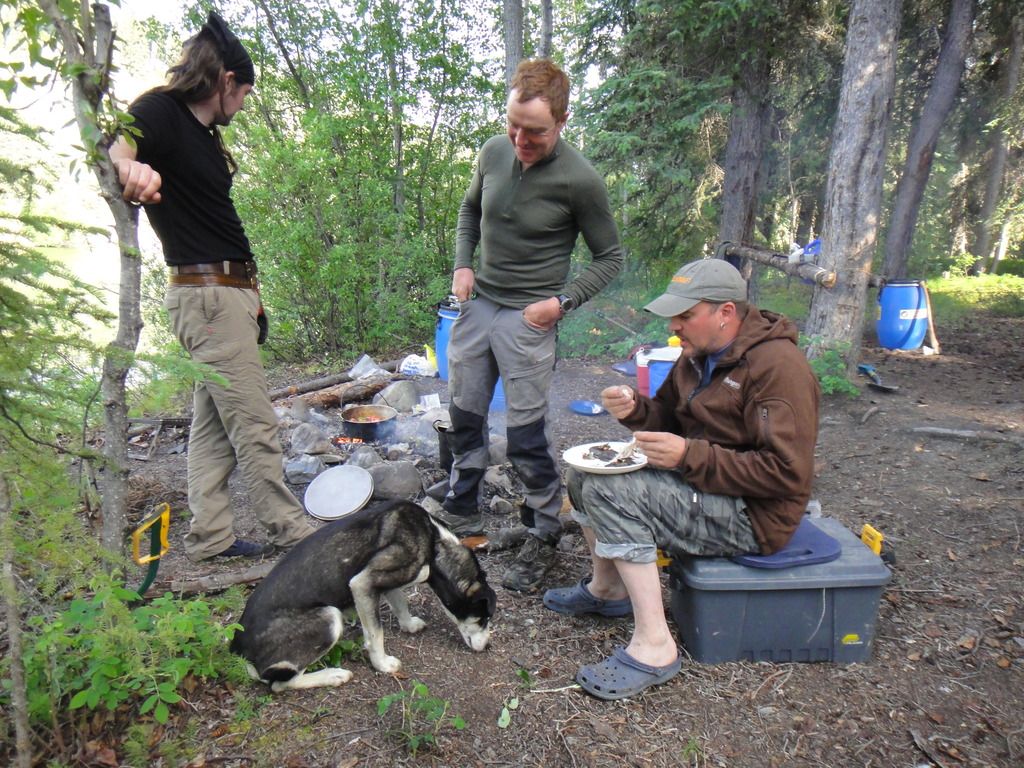
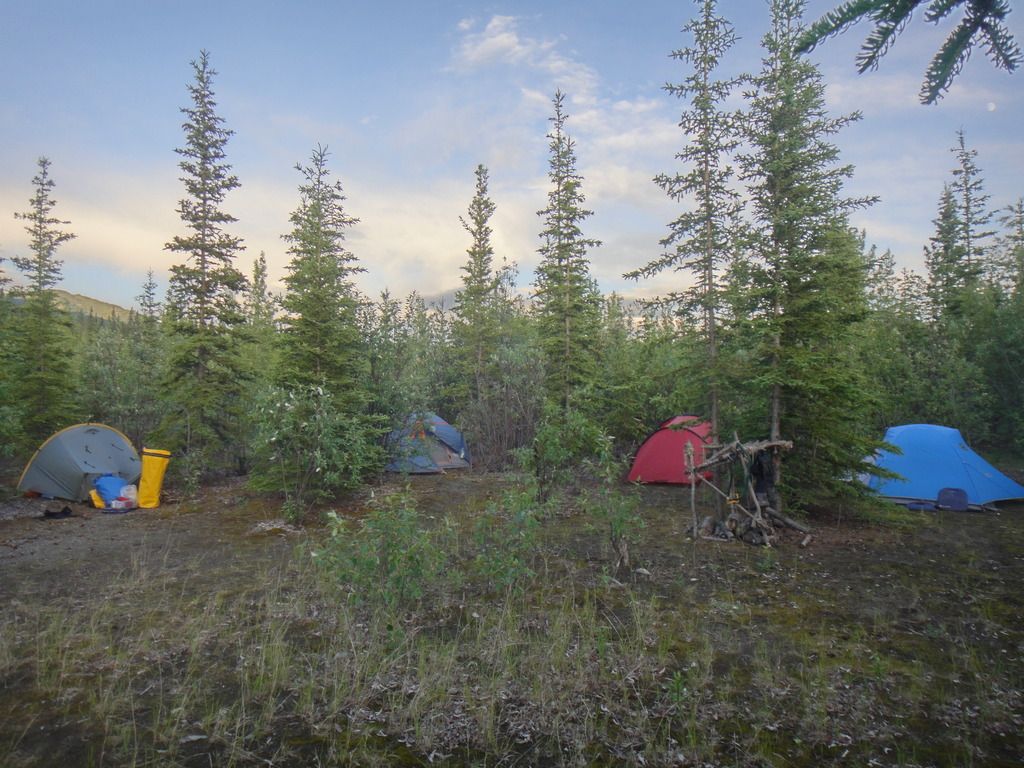
The first couple of days saw us eating eggs, bacon and sausage for breakfast, and pork chops and roast beef for dinner. After this we usually had yoghurt and granola, porridge, bannock, toast or pancakes for breakfast. It was interesting to see the difference between what we typically call bannock and the Yukon version. While ours tends to be like a flat loaf, they prefer to make a batter and fry in grease up there, almost like a thick pancake. They were however, delicious, especially with dried cranberry and coconut.
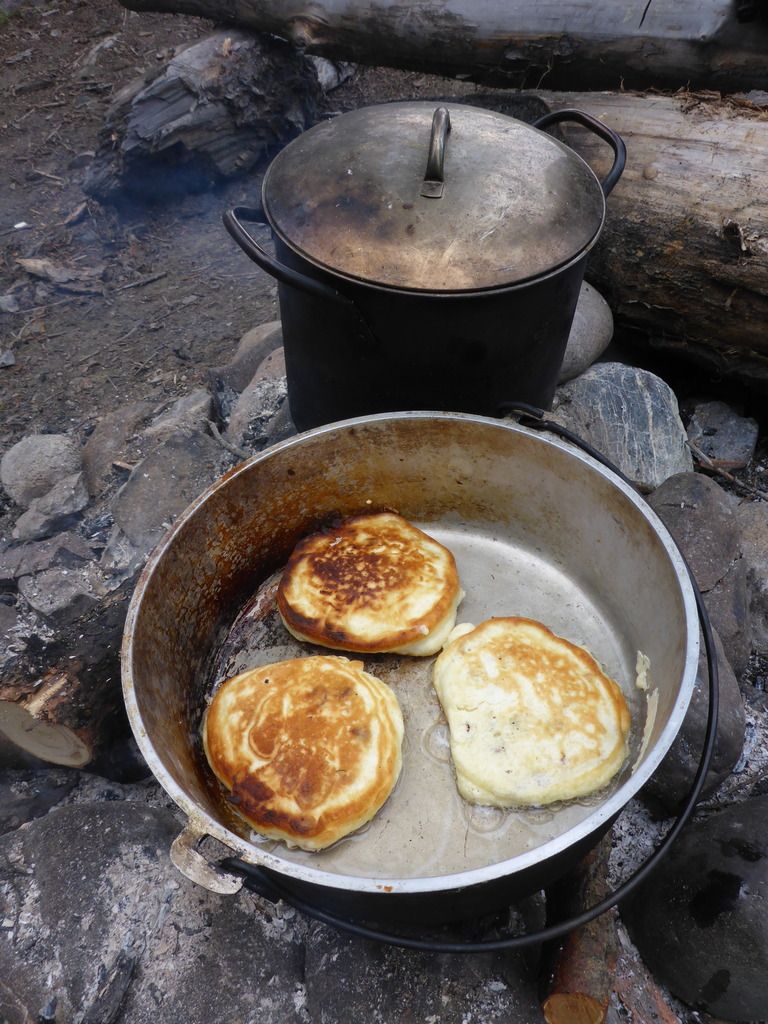
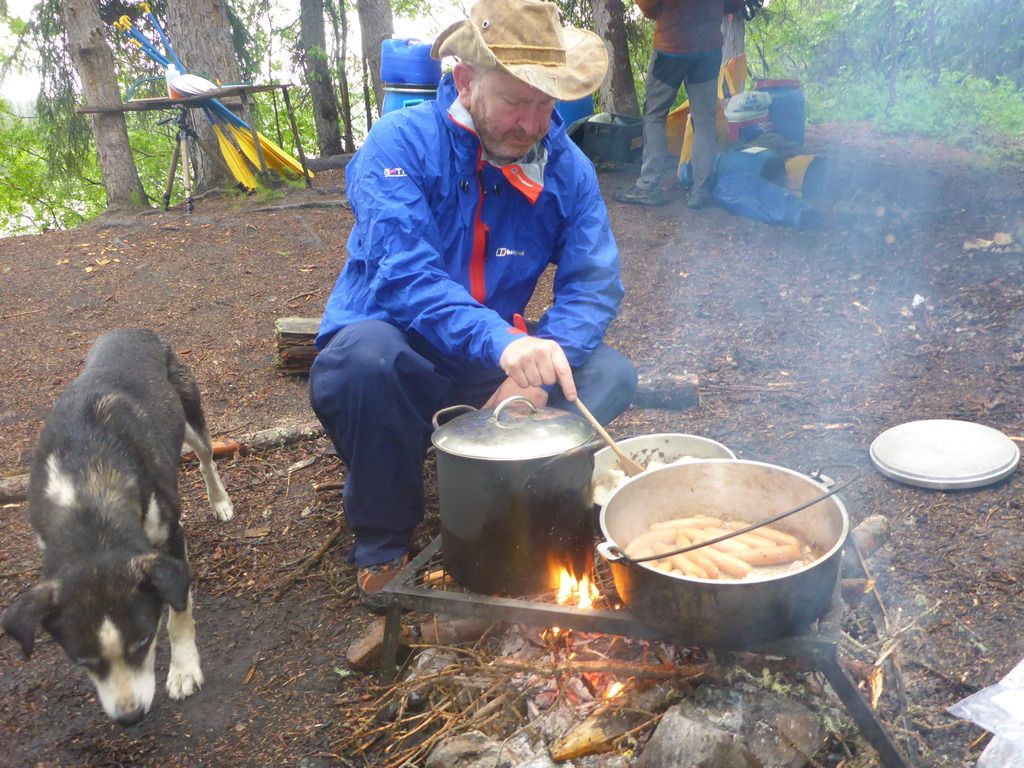
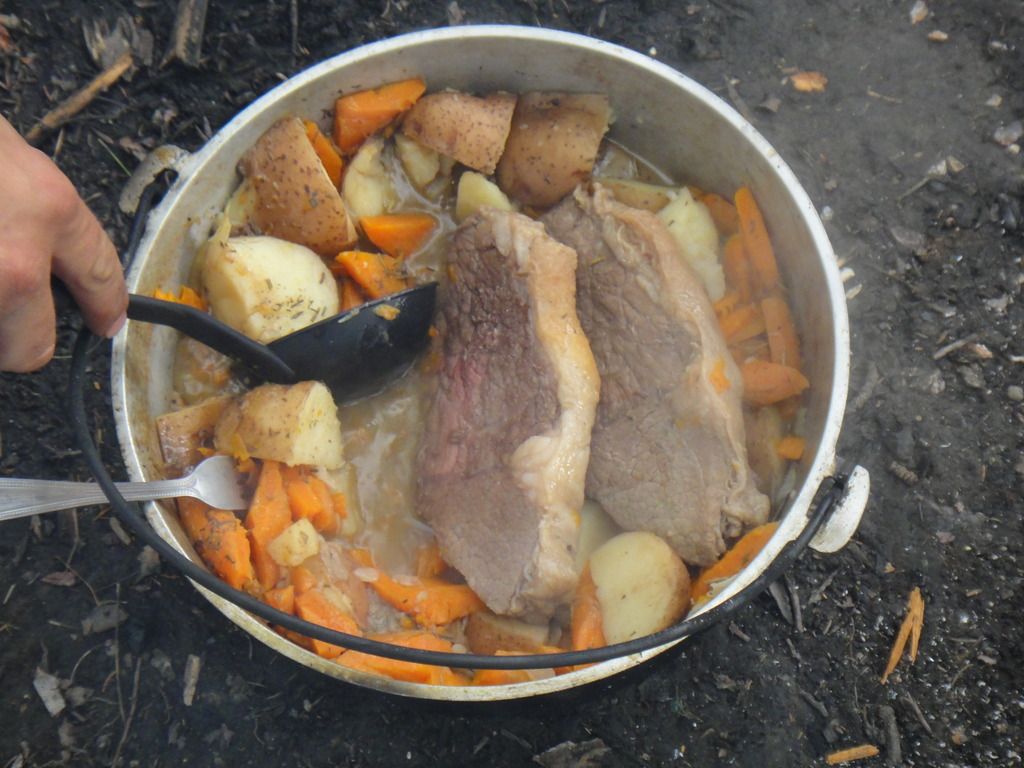
The roast beef on day two was a clear favourite and really perked up our spirits after the tough days paddling. Another highlight was Fabian’s dutch over pizza, which was delicious by any standards, not even considering the fact it was cooked in a dutch oven over a camp fire.
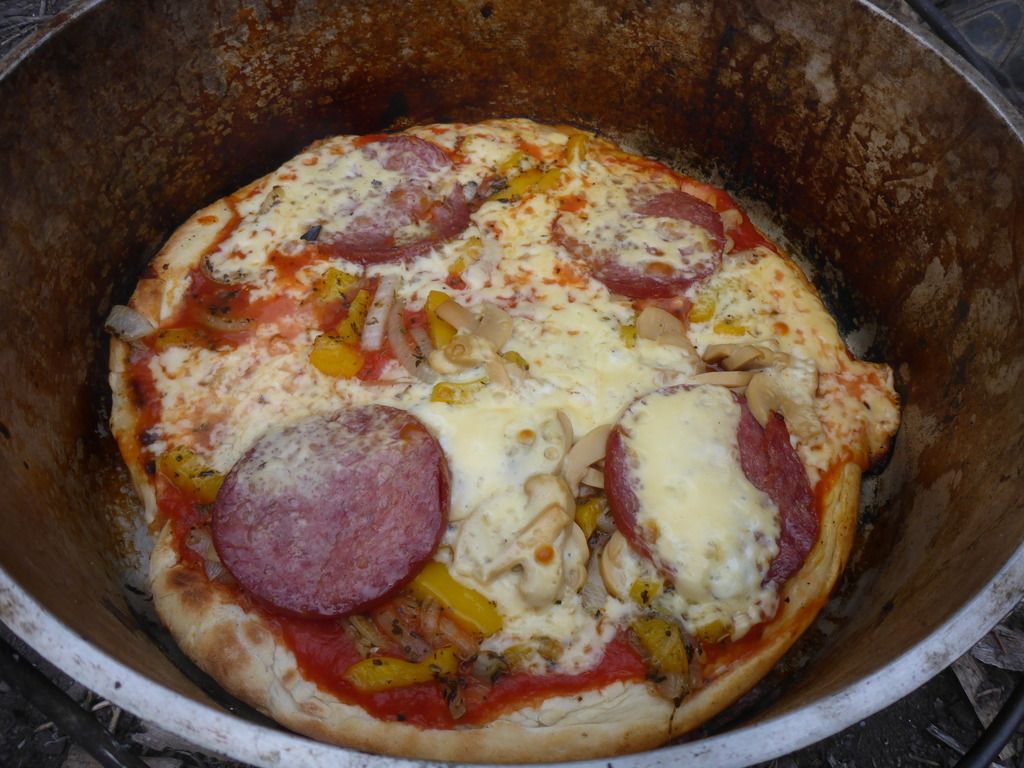
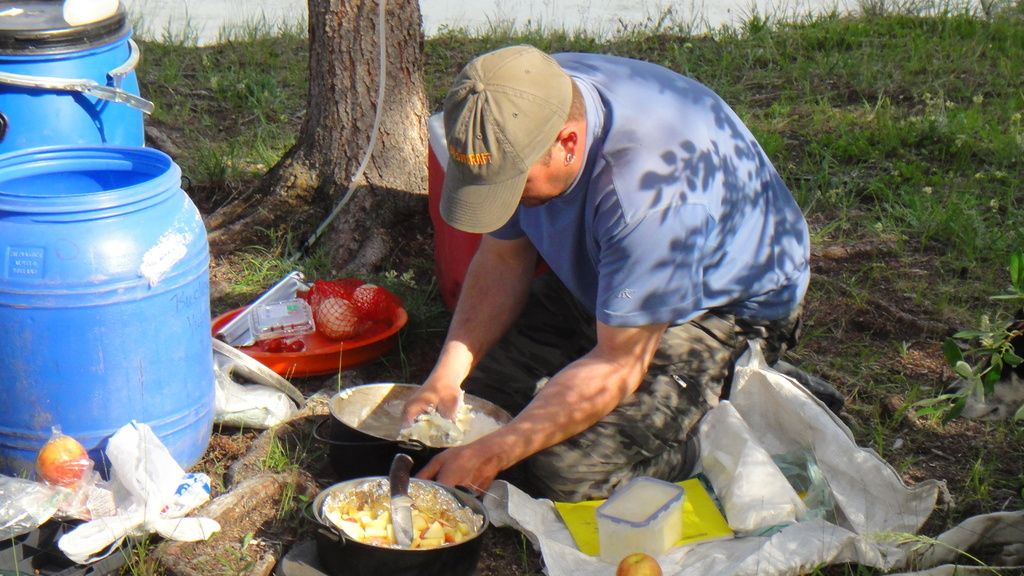
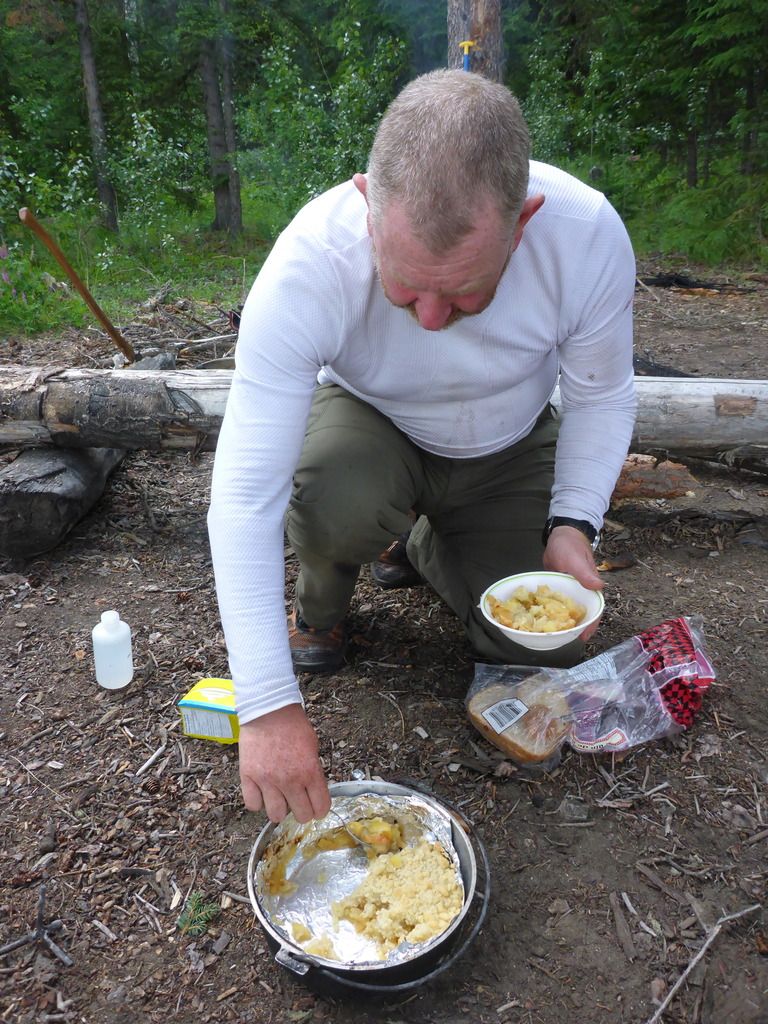
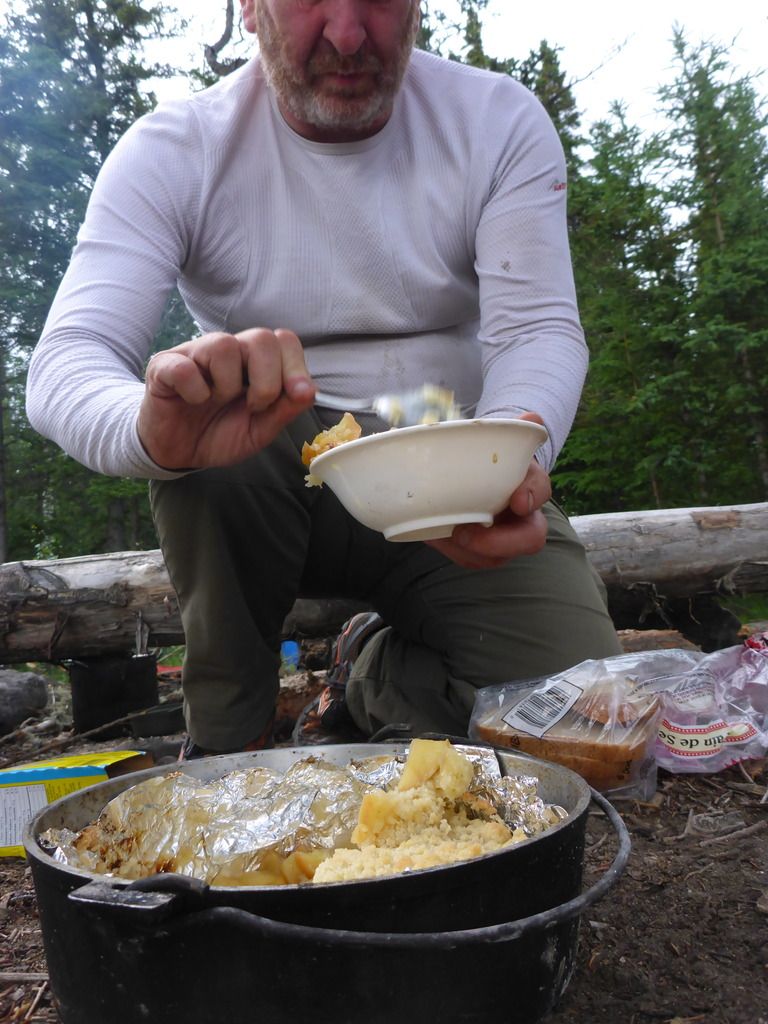

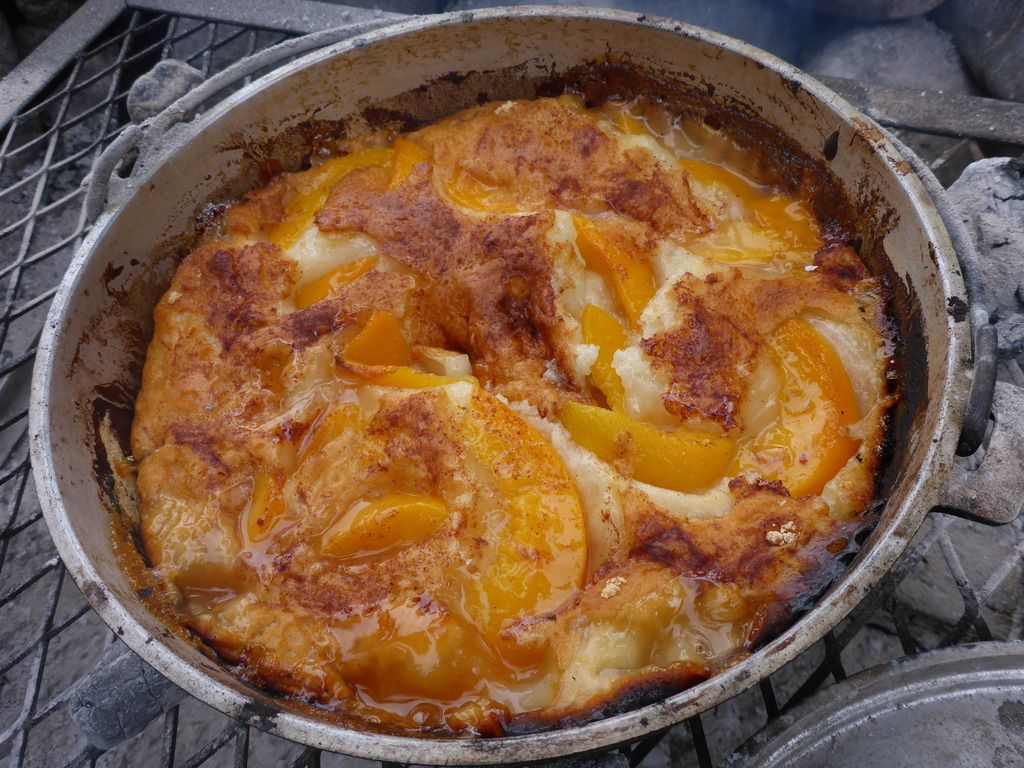
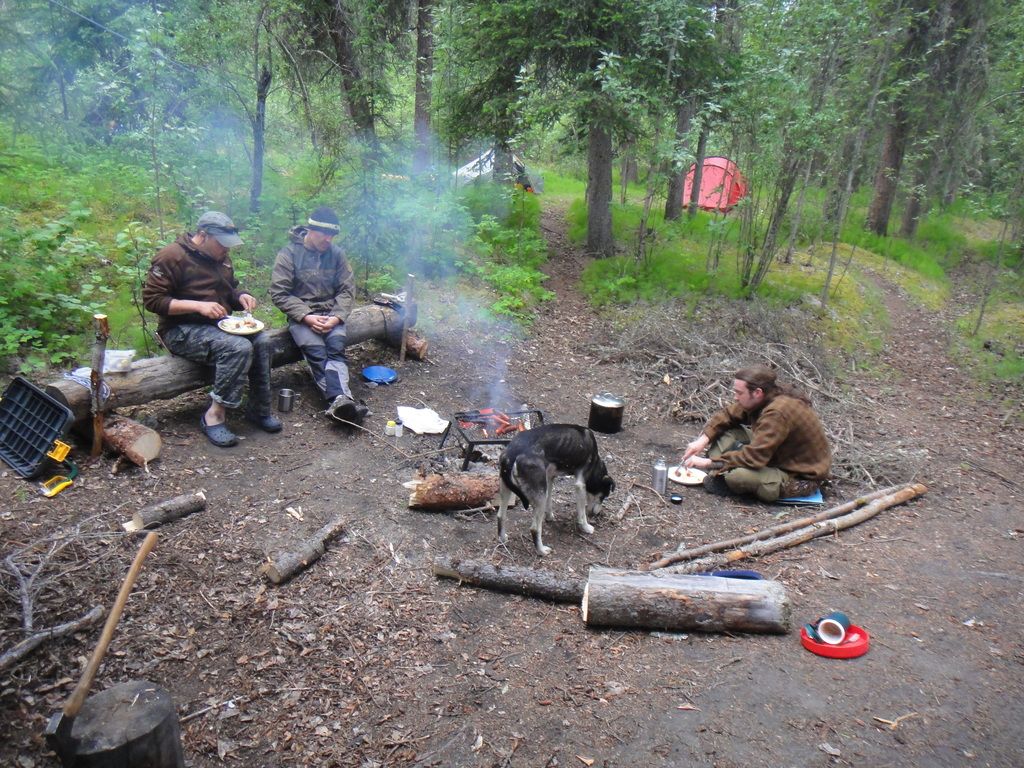
We even got a few deserts throughout the trip. Whether it was chocolate pudding, apple crumble, or peach cobbler, they each went down a storm. There was always some chocolate or candy doing the rounds to keep us all sweet. By the way, If you ever find yourself on a trip with Fabian, he will greatly appreciate you bringing along a few bags of winegums - they’re just not the same in Canada apparently.
It was always handy to have a few chocolate bars at the ready incase we needed to motivate anyone to paddle faster.
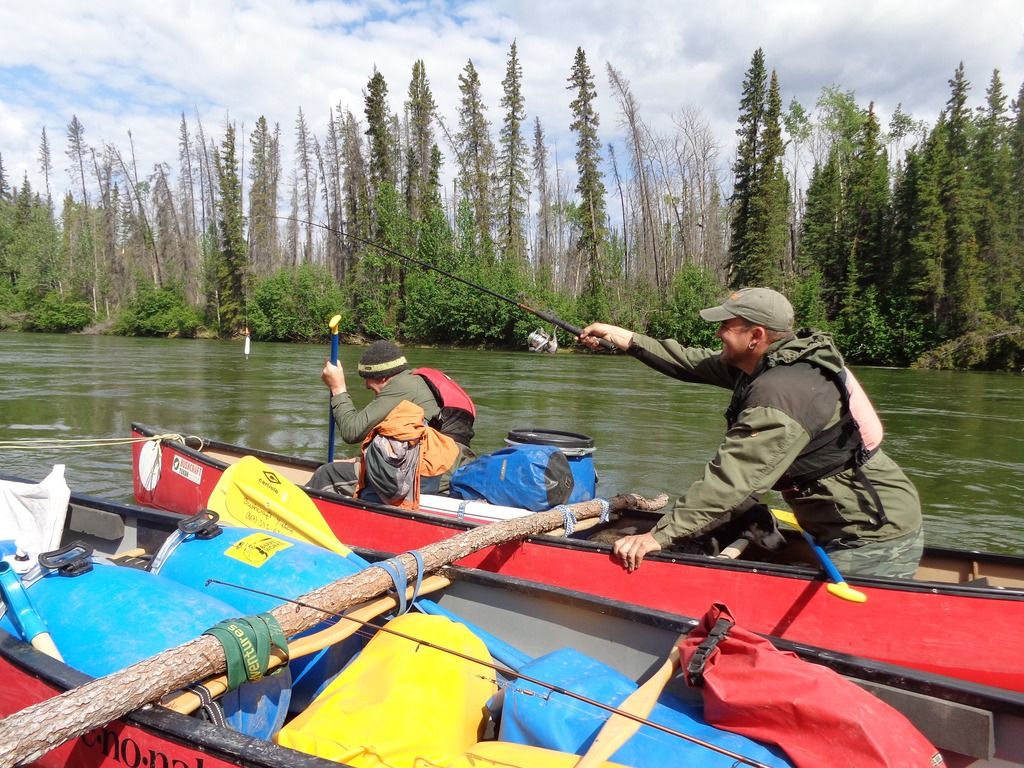
Lunch was usually bread, salami and cheese with granola bars and dried fruit to keep our energy levels up. Not stopping for a hot lunch allowed us to reach our camp each evening with time enough to squeeze in some bushcraft workshops. We generally stopped on small islands like this for lunch:

When the fresh bread ran out, Bob treated us to delicious bread baked daily in the dutch oven. He did white, brown and raisin flat-bread - all of which were very accomplished and didn’t last long!
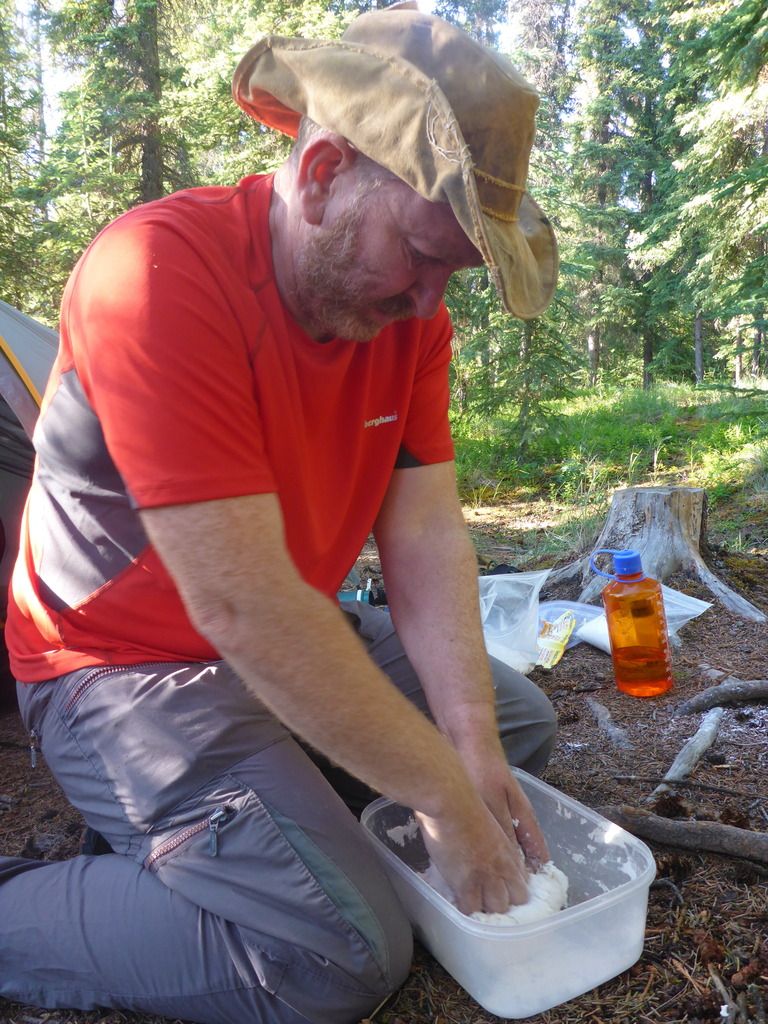
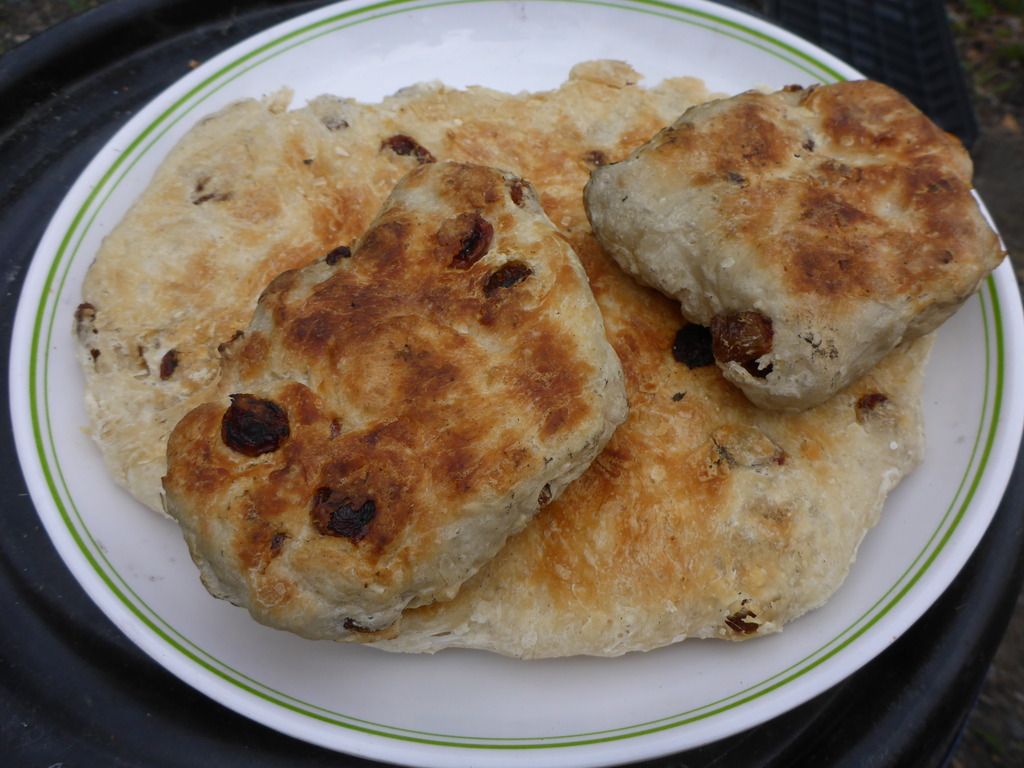
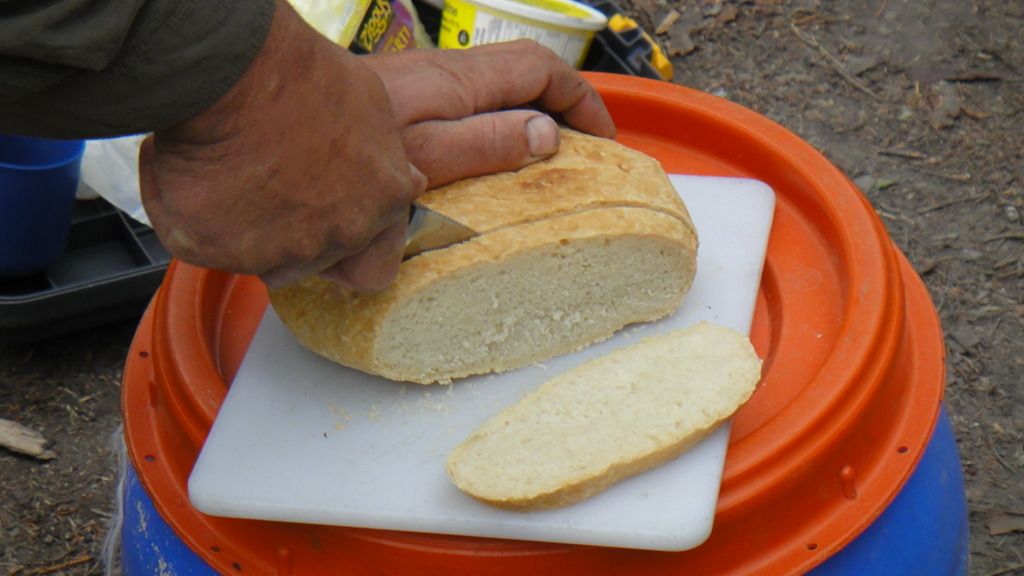
We cooked fish up as we caught them. When two grayling were left on the grill a bit long one night they came off almost smoked, so we decided it might be nice to build a little smoker the next day. The smoker was made from green willow, moss and earth and worked well for a little while - but of course, we chose the hottest day of the trip for this and the bloody thing turned into a signal fire. A few barrels of water sorted that out, but we lost the two fish on the process.
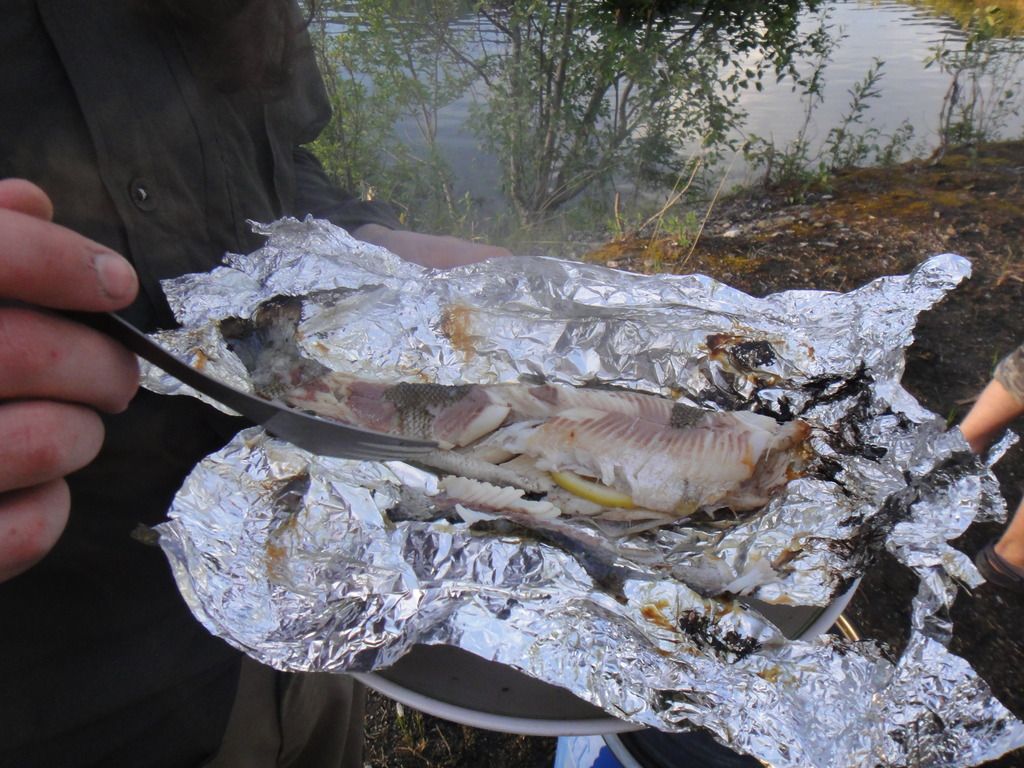

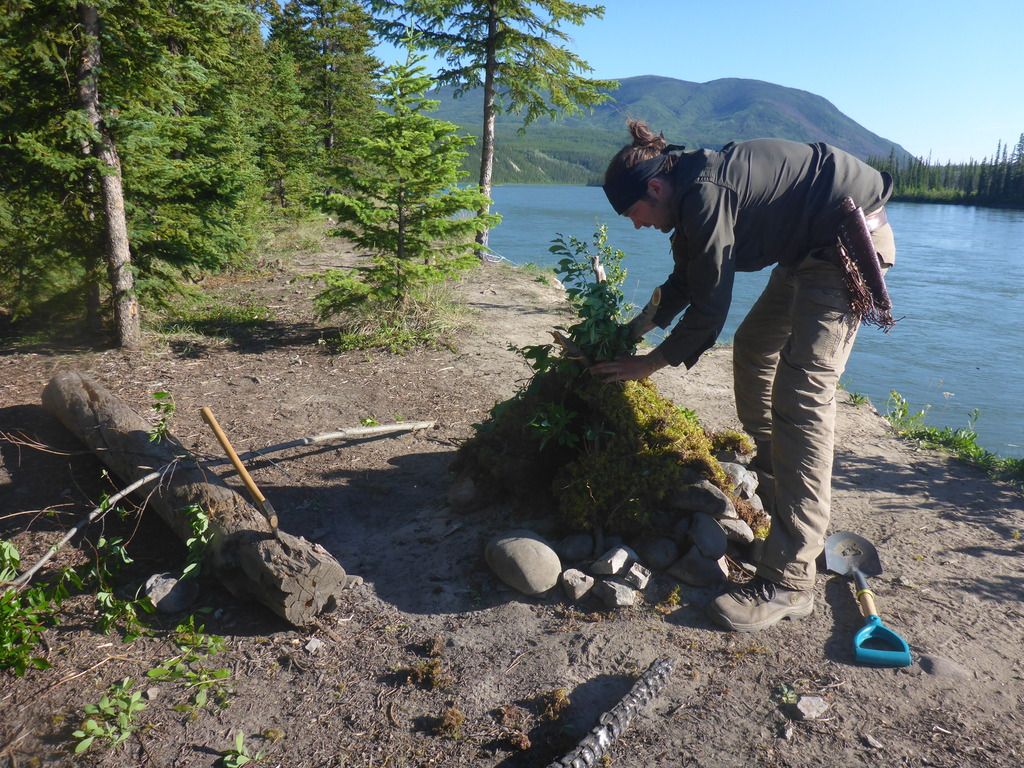

Fabian envisaged the trip as a good opportunity to exchange knowledge, and a preliminary list of bushcraft workshops was drawn up before we set out. As it turned out, it was difficult to fully complete some of the longer projects as we had to make our km target each day, but we got a taste of most of the planned activities and even managed to get a few extras in along the way.
The following is a list of the activities we did on the trip, but I’m probably forgetting something:
Canvas sewing - making a sailors ditty bag the traditional way. This took quite a bit of time, so the guys ended up taking their almost finished projects home. Hopefully they will add pics in when they are finished as they did very well.
Demonstrating some basic stitches:
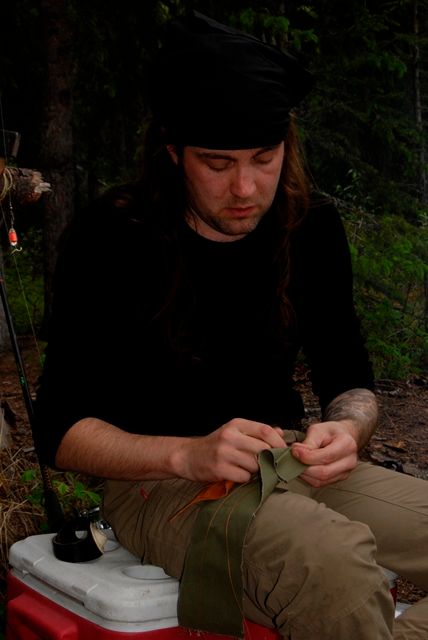
Fabian's bag halfway through:
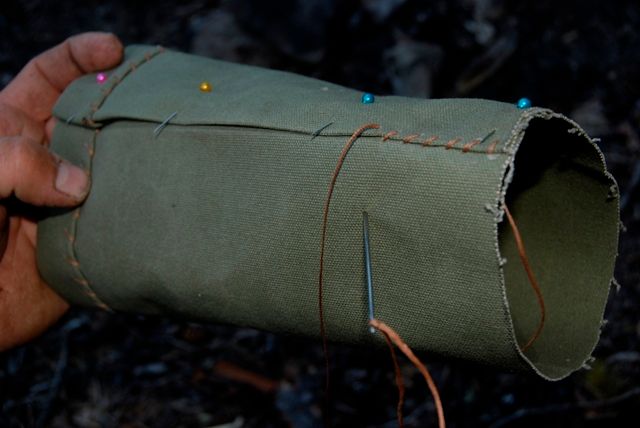
Sheath making
Net making
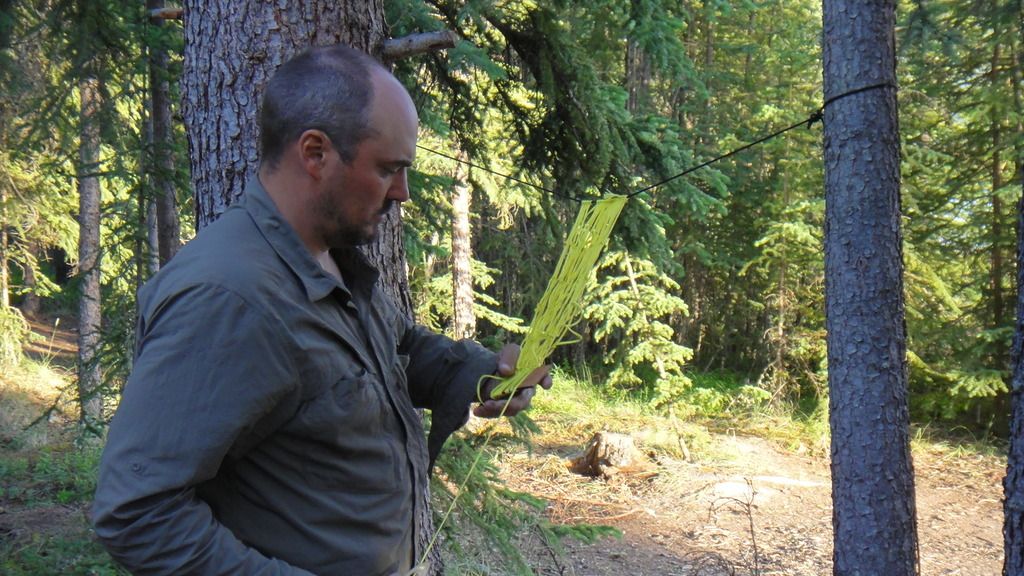

Knife sharpening and stropping

Rope work - Bob did improvised harnesses and stretchers before testing them out!
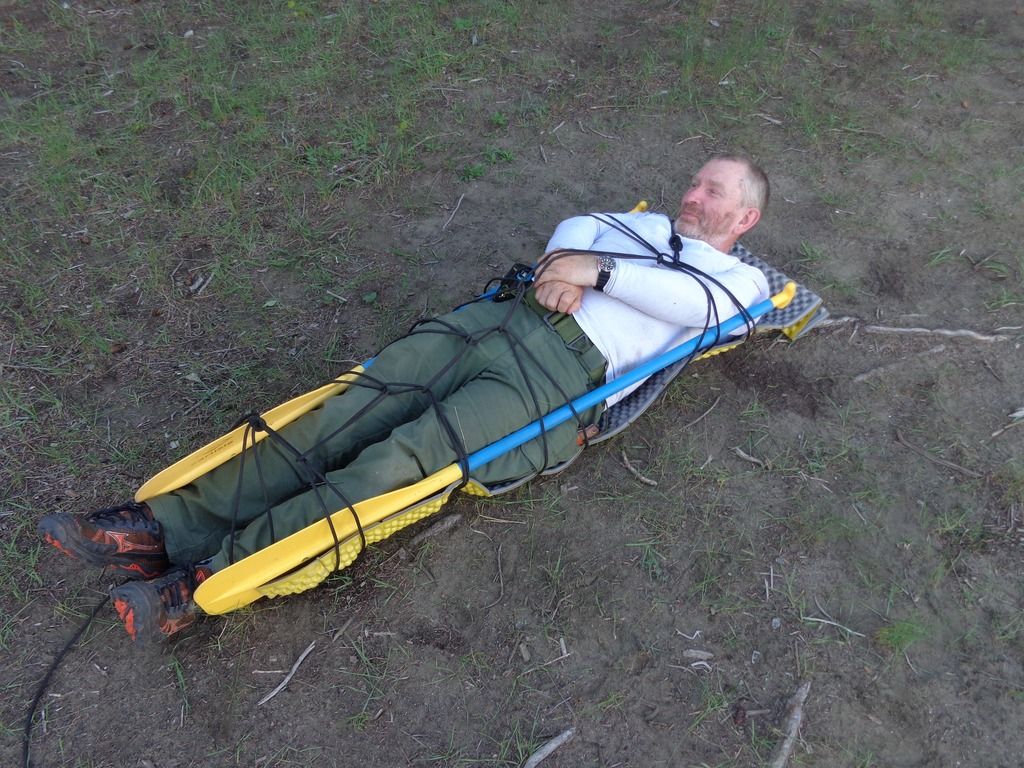


Dutch oven cooking
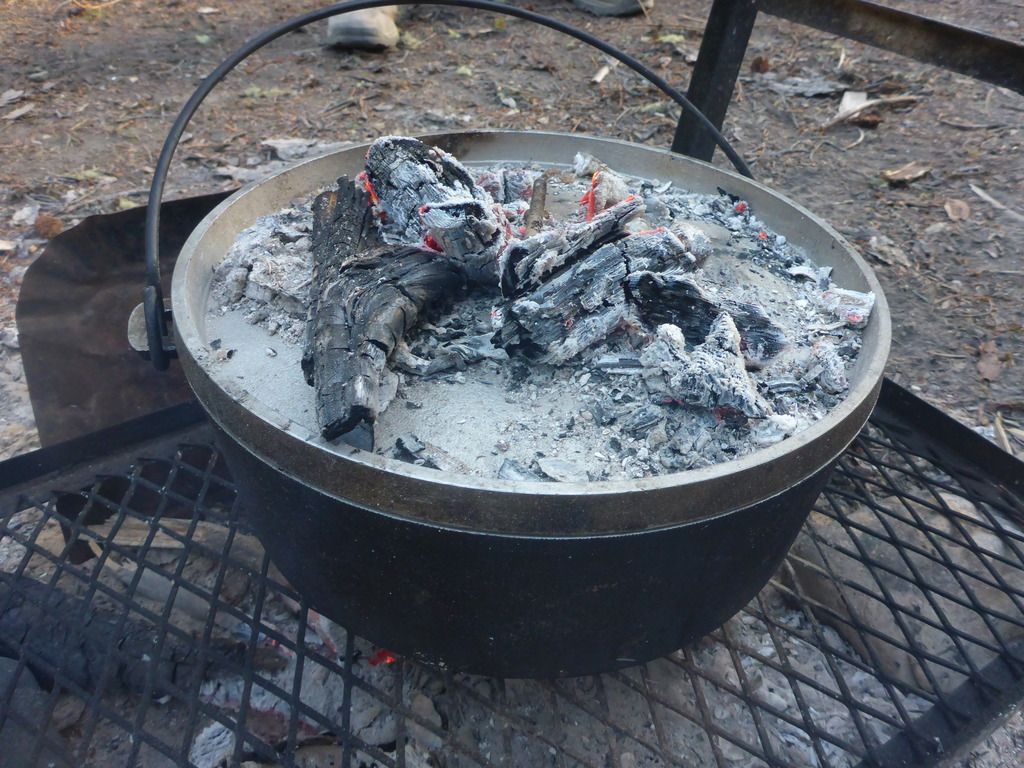
Traps and snares - Fabian shows us some typical traps and we practiced snares for rabbit, red squirrel and ground squirrel. We tried our luck setting some ground squirrel snares overnight, but had no luck. It was an extremely hot day, so that might have something to do with it.


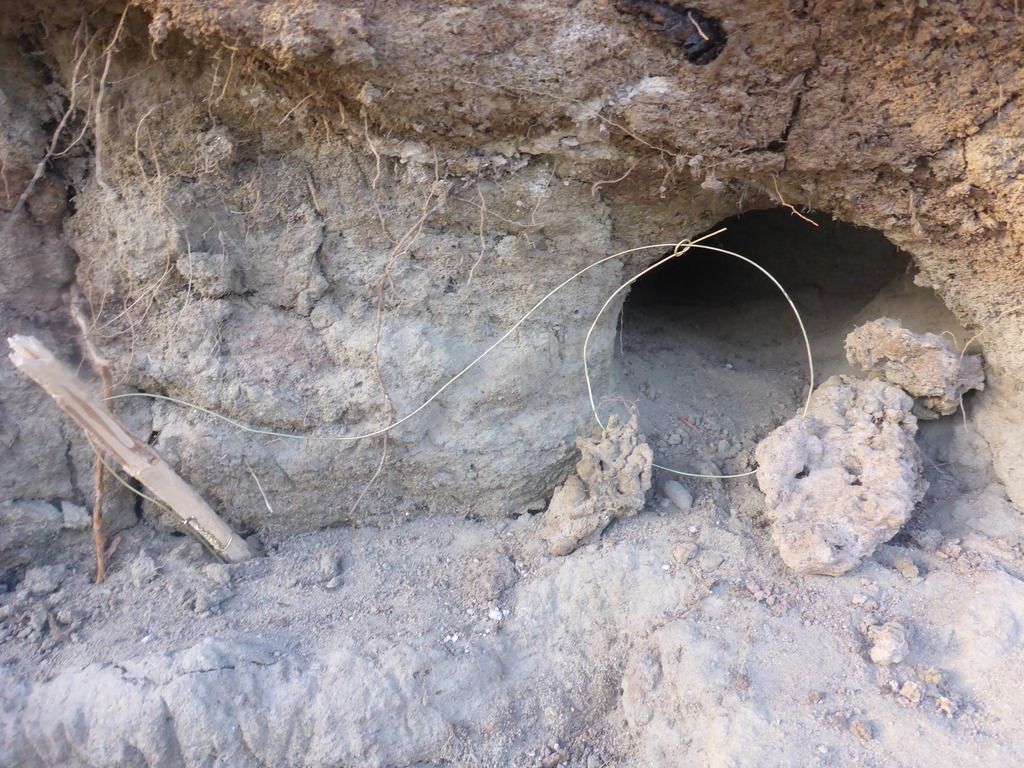
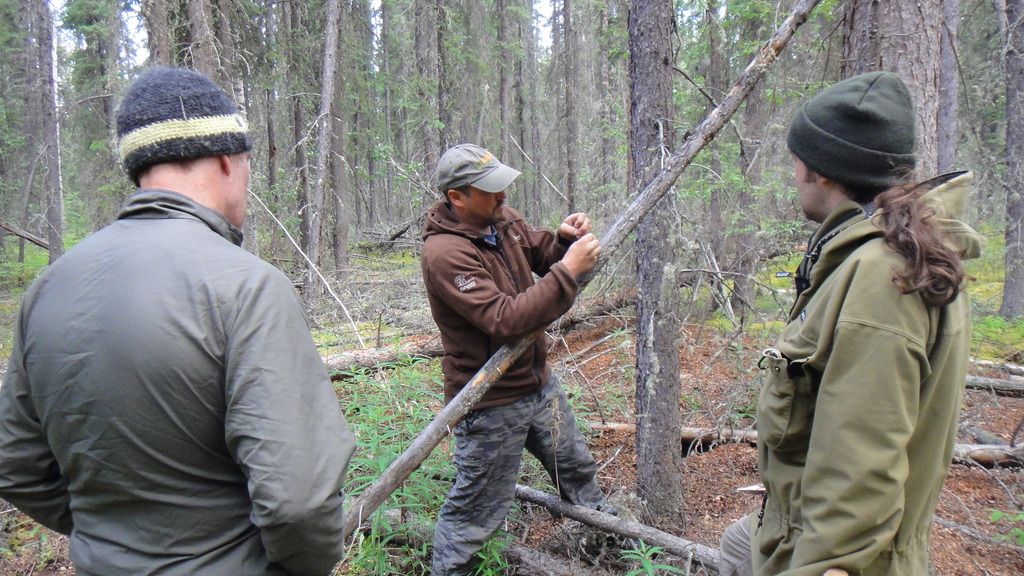
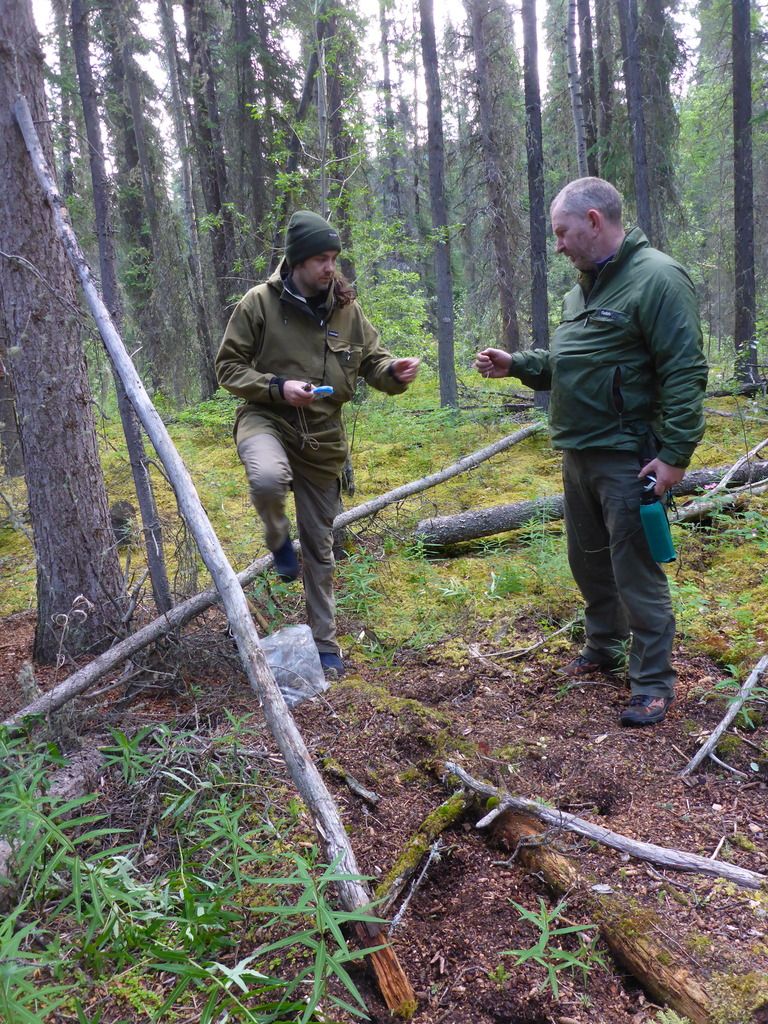
Making spruce salve
Making birch oil
Making a bow-saw handle
Map and compass
Canoeing techniques
Making a canoe raft
This was a truly amazing trip, one that would not have been possible without Fabian’s organisation, experience and equipment. It says it all that by the end he was talking about organising another. I'm tempted to say it was a once in a lifetime experience, but I'm hoping to get back some time and try my hand at a few of the tougher rivers and tackle some white water. It’s pretty hard to sum up such a fantastic trip in a few thousand words, but I hope I’ve given you a flavour of what the Yukon has to offer.
I enjoyed the canoeing here so much I’m looking into buying my own second-hand canoe and finding some suitable canoe-camping spots in Ireland. All-in-all I’m hooked and would jump at the opportunity to go back. It was a rare pleasure to experience such wilderness and tranquility.
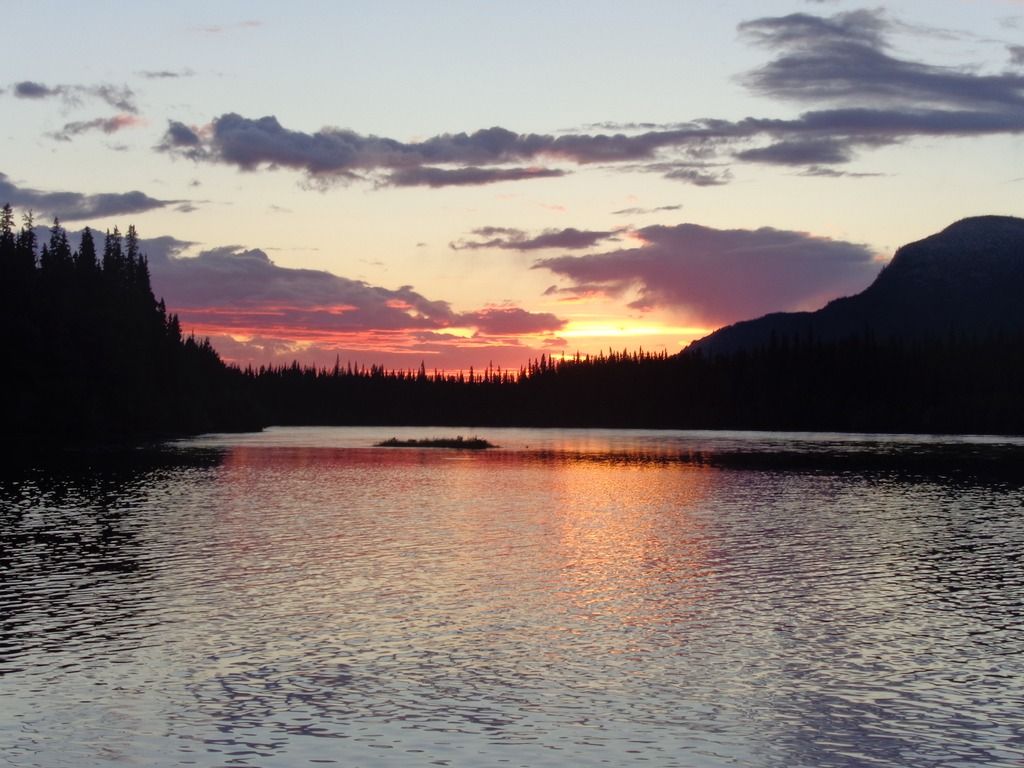
Earlier this year I took up the generous offer from Fabian of Bushcraft Yukon to embark on a ten-day, 400km trip down the Teslin and Yukon rivers in June. At the time it seemed like an age away, but the months flew by and I found myself stuck for time in the end to finish the canvas canoe pack and new camp knife I had promised myself to make for this trip. However, despite the last minute rush I got them finished in time and was rather pleased with the outcome. I always wanted an excuse to make a large canvas canoe pack. This one is completely handmade, all hand stitched too!



My camp knife started with a hand forged blade in W2 by master blade smith J. Neilson. I handled it in wych elm burl and did a unique pin set up and a indulged myself by making a carved, fringed, beaded, ‘frontier fresh’, pouch sheath.


Both proved excellent throughout the trip, but I’ll tell more about these in a separate thread.
It took three flights and a total of 22 hours travelling to get to Whitehorse in the Yukon, but it was worth it. Seeing the scenery on the last plane in made me forget about the jet-lag, for a while anyway.
Fabian and Bob met me at the airport and once I’d collected my canoe-pack from baggage reclaim we headed out to Fabian’s place about an hour outside of town. It was quite late when we arrived, so there was just enough time to pitch the tent and get some rabbit stew before bed - but not before being issued with a can of bear spray and a bear barrel though! All food, suncream, toothpaste and anything else remotely edible to a bear had to be sealed tight each night and left a sensible distance from our tents.
The next morning Bob, Fabian, Kevin and I took a short hike to a nearby viewpoint to talk about the trip, what route we would take, etc. and get a look at the map to get our bearings. Fabian showed us the river guide he would use to help plan where to make camp along the way. It was a useful book and I decided to pick up a copy in the bookstore myself and try follow it along the way. I have to say it was great to know what was coming up ahead in the river and how far we had to make camp. It made finding lunch spots much easier too.

Here is a picture of our route from Johnson's crossing, in the bottom right to Carmacks, a little under 400km.

Here you can see the river guide we used as well as some Yukon literature, hunting and fishing licenses and the accompanying manuals. I was very impressed by how the state regulated hunting and fishing. There is clearly a sense of pride and mutual responsibility here that isn't common in many places. For instance, Fabian told me of the harsh penalties one faced if they didn't use all the available meat on a moose kill. Those currently revising policies in Ireland could learn quite a bit from those in the Yukon.

The day after our scenic planning meeting we packed up our gear and loaded the van and trailer with food and canoes. We had some time before we hit the river to wander round town and pick up last minute items, hunting and fishing licenses.



The first day at Fabian’s, it was decided (while I was sleeping off the jet-lag) to take three canoes between 4 of us. So I got a nice surprise when I was volunteered to paddle solo on the first day when we were loading the boats at Johnson’s crossing. It also meant we had room to bring Clein, Fabian’s Alaskan Husky - who was great company on the trip, even if she did make me miss my dog even more.



It was tough to keep up with the harsh head winds and I was pretty tired by the end of the first day, as was everyone else. We were slow to empty the canoes on day one before we chose our sites and pitched tents a sensible distance from where we cooked and kept our food. The following morning we were very slow to pack up and get moving. However, as the trip progressed we fell into routine and we were usually up around 7 and had everything packed and on the river by 9.30. In good conditions we made camp in the evening’s around 4 after taking a brief lunch break during the day, but the first few days were far from ideal conditions.

This was one of my favourite camp sites:

We started off with two days of brutal headwinds that made paddling even tougher for us three novices. By day three we decided to make a three-canoe raft to help us overcome the now 3 foot high, white tipped waves that were pushing up stream. However, it still wasn’t enough and when we stopped to take a picture of a moose, the now 30 mph headwinds pushed us upstream faster than we had been paddling downstream - a measly 2kph! We were forced to take refuge in a small creek to try wait out the fierce winds. It looked like the perfect spot for pike, but nothing was biting that day. We made a quick fire and put some tea on and took a well deserved rest.



It was so bad on these first three days that there was talk of changing our take-out point to Little Salmon, since it seemed as though we would get no further no matter how hard we paddled. After a few hours, there was no change so we decided to brave the wind again. We didn’t get far before a thunder storm came in. We took refuge in a small, well hidden camp and decided to cook dinner there and hope the weather would break so we could get a few more miles in before the day was out. Things did ease up a little, and that was the last evening we faced such punishing winds on our trip. However, the extra day we had scheduled for a two-day camp and some longer bushcraft activities had been lost due to the slow progress.
On the bright side, we still had enough time to get to Carmacks in time and paddling for the rest of the trip was a breeze compared to those first three days.
For the rest of the trip we had a mix of the three-canoe raft, a two-canoe raft with one solo boat and a tandem with two paddling the raft. The weather was a mix of blazing sunshine, showers and the odd thunder storm. Lightning actually struck quite close to the boat when I was by the river one day, but overall I think we were very lucky with the weather - we got all the bad stuff out of the way early.




Most days we paddled between 45 and 60 km without ever feeling too tired. The Teslin starts off rather slow, which is great when learning the basics but meant we had to work extra hard at the beginning. As the trip progressed, so too did the speed of the current. Towards the end of the trip it was fast enough for us to make 13 kph just drifting. It was great to sit back, listen to the river and watch the wildlife as we drifted along. It was so peaceful we all fell asleep at one time or another.
Of all the varieties of paddling we did I most enjoyed the days where I got to paddle solo. With the river so quit this early in the season, when paddling in front there were times when I felt like I was the only one there - truly wonderful.




The scenery in the Yukon is truly breathtaking. The rivers are dominated by endless spruce trees, bordered by willows and poplar, broken on most meanders by impressive sand cliffs and Hoodoos. These were great features to use when following the river guide and map, which was great for planning our days and picking camp sites in advance.

We reached the confluence of the Teslin, Yukon and Thirty-mile rivers at Hootalinqua a little before halfway through our trip. The dramatic change in water colour was striking as the dull brown of the Teslin met with the brilliant turquoise of the Thrity-mile. We went for a short hike up to a view point to get a better look. From here we could really appreciate the beauty and tranquility of our surroundings. All the cameras came out here as it was a great spot for a few pictures.
Fabian picked up a 1:50,000 map of this area in the bookstore before we set off so he did a little workshop on map and compass work here.

There were plenty of cabins along the river in various states of disrepair. At Hootalinqua a conscious effort is being made to preserve those present and the artefacts within.




I can’t imagine how difficult it must have been to spend a winter in some of these cabins back when the river was busy with stern wheelers and prospectors streaming down the river in search of their fortunes.
There is an old stern wheeler abandoned on an island at Hootalinqua, which was worth a stop to investigate.

Evidence of the gold rush is everywhere if you stop to look. We saw old water pumps and sluice boxes, as well as an impressive dredge built by two enterprising brothers from an old caterpillar tractor and some spare car parts. They floated it down the river from Whitehorse and staked a claim to a sand bar after being shot at along the way by protective prospectors. Despite raking in 72 ounces of gold dust in just twenty days, they left the dredge behind and never returned. That would be worth $96,264 at todays prices.





We saw a good variety of wildlife along the way, but the bears never made an appearance.
We saw red squirrels and ground squirrels often and were treated to many moose sitings along the way, getting quite close to some. In each case they were cows with one of two calves in tow.



We saw bear scat and tracks, and some grizzly fur where one had been scratching at one of our camps. We also saw alot of moose tracks in some of our camps.

We also saw beavers and a porcupine. We had discussed possibly getting a porcupine before the trip, to supplement our meat as it ran out. When we spotted the porcupine on a sand cliff ambling along we decided to try bag it. A brief explosion of rapid paddling and I jumped out armed with a wooden paddle and ready to bag us two days worth of meat. But hardly half way up the cliff and I heard shouts of ‘someone tie the boat up’! As I looked back to see our raft drifting away I decided to race back and tie it up. Fabian and I tried tracking the porcupine but he went into very thick bush at the top of the cliff and we lost him. It was a little disappointing, but nothing could put a dampener on such a wonderful trip.

Every day we saw bald eagles, even getting a glimpse of a nest one morning after breakfast.


We also saw a couple of hawks along the way and a host of other birds including: various duck varieties, swans, Canadian geese, kingfishers, and loons (the Canadian National bird featured on the one-dollar coin, colloquially known as a ‘looney’

The fishing in the Yukon was great. With Fabian’s expert local knowledge we could easily pick the right spots to bag Arctic grayling and pike along the way. The pike weren’t biting the first few days - probably due to the rough weather making the water a little murky. Half way through the trip I caught a small pike in a pond at Hootalinqua, just in time for dinner and after we ran out of meat too. It wasn’t the best of eating fish due to a slightly murky taste and those damned pike bones, but it was something different and was a good addition to the rice and veg that night.



On day three we caught our first grayling of the trip and we had no trouble from then on. It might have something to do with me accidentally sacrificing my binoculars to the river a half hour earlier!



Fabian had the shopping done by the time we got there and he made sure we were well fed along the way, as even after two tough days these smiling faces demonstrate:

All cooking was done over the fire in the dutch oven. Water was purified using a Katadyn gravity filter or boiled in a pot for tea.
We were shocked to find just how easy it is to light a fire in the Yukon. There is an abundance of dry material for the taking and plenty of dead standing trees to fell. For the most part one needed only collect a few dry, low hanging spruce branches and whip out a lighter. A bit of dry grass from the base of a tree was enough to catch a spark if you preferred a fire-steel and there was old-man’s beard and spruce sap in large quantities if needed. We saw a lot of tinder fungus and sap wood around our camps, but nobody seems to bothers with it up there since it is so easy to make a fire.
We collected, cut and split wood as a group throughout the trip and it worked very well.
There isn’t a great variety of trees, and for the most part spruce was used. It made for a hot, fast burning fire and was fine for our needs. Suitable camp sites along the river banks usually had a small ring of rocks to contain a fire and occasionally a rough bench or table of logs thrown together by fishermen using them regularly.


The first couple of days saw us eating eggs, bacon and sausage for breakfast, and pork chops and roast beef for dinner. After this we usually had yoghurt and granola, porridge, bannock, toast or pancakes for breakfast. It was interesting to see the difference between what we typically call bannock and the Yukon version. While ours tends to be like a flat loaf, they prefer to make a batter and fry in grease up there, almost like a thick pancake. They were however, delicious, especially with dried cranberry and coconut.



The roast beef on day two was a clear favourite and really perked up our spirits after the tough days paddling. Another highlight was Fabian’s dutch over pizza, which was delicious by any standards, not even considering the fact it was cooked in a dutch oven over a camp fire.







We even got a few deserts throughout the trip. Whether it was chocolate pudding, apple crumble, or peach cobbler, they each went down a storm. There was always some chocolate or candy doing the rounds to keep us all sweet. By the way, If you ever find yourself on a trip with Fabian, he will greatly appreciate you bringing along a few bags of winegums - they’re just not the same in Canada apparently.
It was always handy to have a few chocolate bars at the ready incase we needed to motivate anyone to paddle faster.

Lunch was usually bread, salami and cheese with granola bars and dried fruit to keep our energy levels up. Not stopping for a hot lunch allowed us to reach our camp each evening with time enough to squeeze in some bushcraft workshops. We generally stopped on small islands like this for lunch:

When the fresh bread ran out, Bob treated us to delicious bread baked daily in the dutch oven. He did white, brown and raisin flat-bread - all of which were very accomplished and didn’t last long!



We cooked fish up as we caught them. When two grayling were left on the grill a bit long one night they came off almost smoked, so we decided it might be nice to build a little smoker the next day. The smoker was made from green willow, moss and earth and worked well for a little while - but of course, we chose the hottest day of the trip for this and the bloody thing turned into a signal fire. A few barrels of water sorted that out, but we lost the two fish on the process.




Fabian envisaged the trip as a good opportunity to exchange knowledge, and a preliminary list of bushcraft workshops was drawn up before we set out. As it turned out, it was difficult to fully complete some of the longer projects as we had to make our km target each day, but we got a taste of most of the planned activities and even managed to get a few extras in along the way.
The following is a list of the activities we did on the trip, but I’m probably forgetting something:
Canvas sewing - making a sailors ditty bag the traditional way. This took quite a bit of time, so the guys ended up taking their almost finished projects home. Hopefully they will add pics in when they are finished as they did very well.
Demonstrating some basic stitches:

Fabian's bag halfway through:

Sheath making
Net making


Knife sharpening and stropping

Rope work - Bob did improvised harnesses and stretchers before testing them out!



Dutch oven cooking

Traps and snares - Fabian shows us some typical traps and we practiced snares for rabbit, red squirrel and ground squirrel. We tried our luck setting some ground squirrel snares overnight, but had no luck. It was an extremely hot day, so that might have something to do with it.





Making spruce salve
Making birch oil
Making a bow-saw handle
Map and compass
Canoeing techniques
Making a canoe raft
This was a truly amazing trip, one that would not have been possible without Fabian’s organisation, experience and equipment. It says it all that by the end he was talking about organising another. I'm tempted to say it was a once in a lifetime experience, but I'm hoping to get back some time and try my hand at a few of the tougher rivers and tackle some white water. It’s pretty hard to sum up such a fantastic trip in a few thousand words, but I hope I’ve given you a flavour of what the Yukon has to offer.
I enjoyed the canoeing here so much I’m looking into buying my own second-hand canoe and finding some suitable canoe-camping spots in Ireland. All-in-all I’m hooked and would jump at the opportunity to go back. It was a rare pleasure to experience such wilderness and tranquility.

Last edited:
